{"/api/v1/ncpl/currencies/getAll":{"body":[{"Name":"U.S. Dollar","Code":"USD","Symbol":"$","Separator":".","Culture":"en-US"},{"Name":"Euro","Code":"EUR","Symbol":"€","Separator":",","Culture":"en-US"},{"Name":"British Pound","Code":"GBP","Symbol":"£","Separator":".","Culture":"en-US"},{"Name":"Canadian Dollars","Code":"CAD","Symbol":"C$","Separator":".","Culture":"en-US"},{"Name":"Australian Dollars","Code":"AUD","Symbol":"A$","Separator":".","Culture":"en-US"},{"Name":"Indian Rupees","Code":"INR","Symbol":"Rs","Separator":".","Culture":"en-US"},{"Name":"China Yuan RMB","Code":"CNY","Symbol":"¥","Separator":".","Culture":"en-US"}],"status":200,"statusText":"OK"},"/api/v1/ncpl/usermanagement/uiuser/getHeaderUserInfo:\"{\\\"hideSupportPin\\\":true}\"":{"body":{"__ctxId":"BD478C2C5DE34F60836F918AB8CB9B80","__isError":true,"__errorType":"Nc.Platform.Abstractions.UnauthorizedException","Http_WWW_Authenticate":"Bearer","StatusCode":"Unauthorized","LogLevel":3,"Message":"","InnerException":null,"HelpLink":null,"Source":"Nc.Security.Middleware"},"status":401,"statusText":"Unauthorized"},"/api/v1/ncpl/cart/user/getShoppingCartSummary:\"{\\\"finalTotalOnly\\\":true}\"":{"body":null,"status":200,"statusText":"OK"}}{"/api/v1/ncpl/simplekb/getarticle:\"{\\\"articleId\\\":10569,\\\"categoryId\\\":2179}\"":{"body":{"Id":10569,"FriendlyId":"","ArticleTypeId":3,"Title":"How to optimize your Private Email mailbox storage","ArticleName":"How to optimize your Private Email mailbox storage","ArticleSummary":null,"PreponedSummary":false,"Approved":true,"Body":"DQoJCTxwPlNvbWV0aW1lcyBpdCBtYXkgYmUgbmVjZXNzYXJ5IHRvIGNsZWFuIHlvdXIgbWFpbGJveCBhbmQgcmVkdWNlIGl0cyBzaXplLiBZb3UgbWF5IHdpc2ggdG8gYmV0dGVyIG9yZ2FuaXplIHlvdXIgZW1haWxzIHRvIGltcHJvdmUgeW91ciBwcm9kdWN0aXZpdHksIHByZXZlbnQgeW91ciBpbmJveCBmcm9tIGdldHRpbmcgZnVsbCBhbmQgZXhjZWVkaW5nIHlvdXIgcXVvdGFzLCBzbyB5b3UgcmVtYWluIGFibGUgdG8gc2VuZCBvciByZWNlaXZlIGVtYWlscyBhbmQsIGluIHNvbWUgY2FzZXMsIGVuc3VyZSB0aGF0IHlvdXIgZW1haWwgY2xpZW50IHdvcmtzIHByb3Blcmx5LjwvcD4NCgkJPHA+VGhlIGZvbGxvd2luZyB0aXBzICB3aWxsIGhlbHAgeW91IG9wdGltaXplIHlvdXIgUHJpdmF0ZSBFbWFpbCBtYWlsYm94IHN0b3JhZ2UsIHJlZHVjaW5nIHlvdXIgaW5ib3ggYW5kIG1ha2luZyBpdCBlYXNpZXIgdG8gd29yayB3aXRoOjwvcD4NCgkJPHA+DQoJCQkJPGI+MS4gRGVsZXRlIHVubmVjZXNzYXJ5IGVtYWlsczwvYj4NCgkJPC9wPg0KCQk8cD5JdCBtYXkgc291bmQgc2ltcGxlLCBidXQgaXTigJlzIHRoZSBlYXNpZXN0IHdheSB0byBmcmVlIHVwIHNvbWUgc3RvcmFnZS4gV2hlbiB5b3UgcmVjZWl2ZSBhIG5ldyBlbWFpbCwgZGVjaWRlIGlmIGl0IGlzIGltcG9ydGFudCBlbm91Z2ggdG8ga2VlcDsgaWYgbm90LCBkZWxldGUgaXQuIExvb2sgdGhyb3VnaCB5b3VyIGluYm94IGZvciBvdGhlciBpcnJlbGV2YW50IG1lc3NhZ2VzIHRoYXQgY2FuIGJlIGRlbGV0ZWQuIE5vdCBvbmx5IGRvZXMgdGhpcyBzYXZlIHlvdXIgZW1haWwgc3BhY2UsIGl0IGFsc28gYWxsb3dzIHlvdSB0byBtYW5hZ2UgeW91ciBlbWFpbCBjb3JyZXNwb25kZW5jZSBtb3JlIGVmZmljaWVudGx5LiBBZnRlciB5b3UgZGVsZXRlIGFsbCB0aGUgaXJyZWxldmFudCBtZXNzYWdlcywgaXQgd2lsbCBiZSBlYXNpZXIgdG8gZmluZCBpbXBvcnRhbnQgZW1haWxzLg0KPC9wPg0KCQk8cD4NCgkJCQk8Yj4yLiBQZXJpb2RpY2FsbHkgY2xlYW4gVHJhc2gvU3BhbSBmb2xkZXI8L2I+DQoJCTwvcD4NCgkJPHA+QmUgc3VyZSB0byBlbXB0eSB0aGUgVHJhc2gvU3BhbSBmb2xkZXIgZnJvbSB0aW1lIHRvIHRpbWUgaW4gb3JkZXIgdG8gc2F2ZSB5b3VyIHNwYWNlIGZvciBtZXNzYWdlcyB5b3UgYWN0dWFsbHkgd2FudC4gVG8gYWNoaWV2ZSB0aGlzLCBzaW1wbHkgc2VsZWN0IHRoZSBUcmFzaC9TcGFtIGZvbGRlciwgY2xpY2sgb24gdGhlIGZvbGRlci1zcGVjaWZpYyBhY3Rpb25zIGljb24gbmV4dCB0byB0aGUgZm9sZGVyIG5hbWUgYW5kIGhpdCA8Yj5FbXB0eSB0cmFzaC9EZWxldGUgYWxsIG1lc3NhZ2VzPC9iPjo8L3A+DQoJCTxiciAvPg0KCQk8ZGl2Pg0KCQkJCTxpbWcgY2xhc3M9ImtiLWltYWdlIiBzcmM9Imh0dHBzOi8vTmFtZWNoZWFwLnNpbXBsZWtiLmNvbS9TaXRlQ29udGVudHMvMi03QzIyRDUyMzZBNDU0M0VCODI3RjNCRDg5MzZFMTUzRS9tZWRpYS9wZV9lbXB0eV90cmFzaC5wbmciIGtiLWltYWdlIj0iIiAvPg0KCQk8L2Rpdj4NCgkJPGJyIC8+DQoJCTxwPg0KCQkJCTxiPjMuIFJlZ3VsYXJseSBhcmNoaXZlIG9sZCBtZXNzYWdlczwvYj4NCgkJPC9wPg0KCQk8cD5PbmUgbW9yZSBlYXN5IHdheSB0byBvcHRpbWl6ZSB5b3VyIGVtYWlsIHN0b3JhZ2UgaXMgdG8gYXJjaGl2ZSB0aGUgb2xkIGVtYWlscyB5b3Ugbm8gbG9uZ2VyIG5lZWQuIFRoZSBhZHZhbnRhZ2Ugb2YgdGhpcyBvcHRpb24gYXMgb3Bwb3NlZCB0byBzaW1wbHkgZGVsZXRpbmcgZW1haWxzIGlzIHRoYXQgd2hlbiBhcmNoaXZpbmcgZW1haWxzLCB0aG9zZSBlbWFpbHMgYXJlIG1vdmVkIHRvIHRoZSA8Yj5BcmNoaXZlPC9iPiBmb2xkZXIuIFRoZSBBcmNoaXZlIGZvbGRlciBjb250YWlucyBhIHNlcGFyYXRlIHN1YmZvbGRlciBmb3IgZWFjaCBjYWxlbmRhciB5ZWFyLiBUaGUgYXJjaGl2ZWQgZW1haWxzIGFyZSBzYXZlZCB0byB0aG9zZSBzdWJmb2xkZXJzIHNvcnRlZCBieSB0aGUgeWVhciBvZiByZWNlaXB0Lg0KPC9wPg0KCQk8cD5UaGVyZSBhcmUgdHdvIHdheXMgdG8gdXNlIHRoZSBBcmNoaXZlIG9wdGlvbi4gVGhlIGZpcnN0IG9uZSBpcyB0byBhcmNoaXZlIGluZGl2aWR1YWwgZW1haWxzLiBTaW1wbHkgc2VsZWN0IHRoZSBlbWFpbHMgdGhhdCBzaG91bGQgYmUgbW92ZWQgYW5kIGNsaWNrIG9uIDxiPkFyY2hpdmU8L2I+IGljb246IDxiciAvPjwvcD4NCgkJPGRpdj4NCgkJCQk8YnIgLz4NCgkJPC9kaXY+DQoJCTxkaXY+DQoJCQkJPGltZyBjbGFzcz0ia2ItaW1hZ2UiIHNyYz0iaHR0cHM6Ly9OYW1lY2hlYXAuc2ltcGxla2IuY29tL1NpdGVDb250ZW50cy8yLTdDMjJENTIzNkE0NTQzRUI4MjdGM0JEODkzNkUxNTNFL21lZGlhL2luYm94X3Rlc3RfbXNnLnBuZyIga2ItaW1hZ2UiPSIiIC8+DQoJCTwvZGl2Pg0KCQk8YnIgLz4NCgkJPHA+DQoJCTwvcD4NCgkJPHA+QWRkaXRpb25hbGx5LCB5b3UgY2FuIGFyY2hpdmUgZW1haWxzIHdpdGhpbiBhIGZvbGRlciB0aGF0IGFyZSBvbGRlciB0aGFuIDkwIGRheXMuIFNlbGVjdCB0aGUgbmVlZGVkIGZvbGRlciwgY2xpY2sgb24gdGhlIGZvbGRlci1zcGVjaWZpYyBhY3Rpb25zIGljb24gbmV4dCB0byB0aGUgZm9sZGVyIG5hbWUgYW5kIGhpdCA8Yj5BcmNoaXZlIG9sZCBtZXNzYWdlczwvYj46IDxiciAvPjwvcD4NCgkJPGRpdj4NCgkJCQk8YnIgLz4NCgkJPC9kaXY+DQoJCTxkaXY+DQoJCQkJPGltZyBjbGFzcz0ia2ItaW1hZ2UiIHNyYz0iaHR0cHM6Ly9OYW1lY2hlYXAuc2ltcGxla2IuY29tL1NpdGVDb250ZW50cy8yLTdDMjJENTIzNkE0NTQzRUI4MjdGM0JEODkzNkUxNTNFL21lZGlhL3BlX2FyY2hpdmVfb2xkX21zZy5wbmciIGtiLWltYWdlIj0iIiAvPg0KCQk8L2Rpdj4NCgkJPGJyIC8+DQoJCTxwPg0KCQk8L3A+DQoJCTxwPg0KCQkJCTxiPlRJUDwvYj46IElmIHlvdSB3YW50IHRvIGRlbGV0ZSBlbWFpbHMgdGhhdCBhcmUgb2xkZXIgdGhhbiA5MCBkYXlzLCB5b3UgY2FuIGFyY2hpdmUgdGhlbSBmaXJzdCBhbmQgdGhlbiBkZWxldGUgdGhlbSBmcm9tIHRoZSBuZXdseS1jcmVhdGVkIGZvbGRlci48L3A+DQoJCTxwPg0KCQkJCTxiPlRJUCAxPC9iPjogQWZ0ZXIgYXJjaGl2aW5nLCBlbWFpbHMgYXJlIGdyb3VwZWQgaW50byBzdWJmb2xkZXJzIHJlcHJlc2VudGluZyB5ZWFycy4gVGhpcyBtYWtlcyBpdCBlYXNpZXIgdG8gcmV2aWV3IGFuZCBkZWxldGUgZW1haWxzIGluIGJ1bGsuIEZvciBleGFtcGxlLCB5b3UgY2FuIHJlbW92ZSBvbGQgeWVhcnPigJkgZm9sZGVycyB0aGF0IGFyZSBubyBsb25nZXIgbmVlZGVkLjwvcD4NCgkJPHA+DQoJCQkJPGI+Tk9URTwvYj46IEFyY2hpdmluZyBlbWFpbHMgY2FuIGhlbHAgaW1wcm92ZSBwZXJmb3JtYW5jZSwgc3VjaCBhcyBtYWtpbmcgc2VhcmNoIGZhc3RlciwgYnV0IGl0IGRvZXMgbm90IHJlZHVjZSB0aGUgZGlzayBzcGFjZSB1c2VkIGluIHlvdXIgUHJpdmF0ZSBFbWFpbCBtYWlsYm94LiBUbyBmcmVlIHVwIHNwYWNlLCB5b3UgbmVlZCB0byBkZWxldGUgbWVzc2FnZXMgb3IgbW92ZSB0aGVtIHRvIGxvY2FsIHN0b3JhZ2Ugb3V0c2lkZSB5b3VyIG1haWxib3guPC9wPg0KCQk8cD4NCgkJCQk8YnIgLz4NCgkJPC9wPg0KCQk8cD4NCgkJCQk8Yj40LiBBdm9pZCBzdG9yaW5nIGEgbG90IG9mIGVtYWlscyBpbiBvbmUgZm9sZGVyPC9iPg0KCQk8L3A+DQoJCTxwPldlIHJlY29tbWVuZCB0aGF0IHlvdSBrZWVwIG1lc3NhZ2VzIGluIHNlcGFyYXRlIGZvbGRlcnMgcmF0aGVyIHRoYW4ga2VlcGluZyB0aGVtIGFsbCBpbiB5b3VyIGluYm94LiAgWW91IGNhbiBlaXRoZXIgY3JlYXRlIGZvbGRlcnMgYW5kIG1vdmUgZW1haWxzIHRvIHRoZW0gZnJvbSB0aGUgSW5ib3gsIG9yIHlvdSBjYW4gc2V0IHVwIGZpbHRlcmluZyBzbyBjZXJ0YWluIGVtYWlscyBpbW1lZGlhdGVseSBnZXQgc29ydGVkIGludG8geW91ciBmb2xkZXJzLiBZb3UgY2FuIGNyZWF0ZSBmaWx0ZXJzIGluIHlvdXIgUHJpdmF0ZSBFbWFpbCB3ZWJtYWlsIHVzaW5nIDxhIGhyZWY9Imh0dHBzOi8vd3d3Lm5hbWVjaGVhcC5jb20vc3VwcG9ydC9rbm93bGVkZ2ViYXNlL2FydGljbGUuYXNweC85MzkyLzIxNzgvaG93LXRvLXNldC11cC1jdXN0b20tZW1haWwtZmlsdGVycy1pbi1wcml2YXRlLWVtYWlsLyI+dGhpcyBndWlkZTwvYT4uIEp1c3QgY2hvb3NlIDxiPkZpbGUgaW50bzwvYj4gYXMgdGhlIGFjdGlvbiBmcm9tIHRoZSBkcm9wLWRvd24gbWVudSBhbmQgY2hvb3NlIHRoZSBhcHByb3ByaWF0ZSBmb2xkZXIuDQoNCjxiciAvPjxiciAvPjxiPk5PVEU8L2I+OiBXZSByZWNvbW1lbmQgdGhhdCB5b3UgaGF2ZSBmZXdlciB0aGFuIDEwLDAwMCBlbWFpbHMgaW4gb25lIGZvbGRlciBmb3Igb3B0aW1hbCBmdW5jdGlvbmFsaXR5LiBJbiBvcmRlciB0byBjaGVjayB0aGUgbnVtYmVyIG9mIGVtYWlscyBpbiB0aGUgZm9sZGVyLCBqdXN0IG1vdXNlIG92ZXIgYSBmb2xkZXIsIGFuZCB0aGUgYnViYmxlIHdpdGggdGhlIG51bWJlciB3aWxsIHNob3cgdXAuDQo8L3A+DQoJCTxwPg0KCQkJCTxiPjUuIERlbGV0aW5nIHVudXNlZCBmb2xkZXJzPC9iPg0KCQk8L3A+DQoJCTxwPkl0IG1heSBiZSB3b3J0aCByZXZpZXdpbmcgdGhlIGxpc3Qgb2YgeW91ciBmb2xkZXJzIHRvIGRldGVybWluZSBpZiB0aGVyZSBhcmUgYW55ICB0aGF0IHlvdSBubyBsb25nZXIgbmVlZC4gSWYgdGhlcmUgYXJlIGFueSB0aGF0IHdlcmUgY3JlYXRlZCBmb3IgdGVtcG9yYXJ5IHByb2plY3RzL2lzc3VlcyB0aGF0IGFyZSBub3QgcmVsZXZhbnQgYW55bW9yZSwgeW91IGNhbiBlaXRoZXIgZGVsZXRlIHRoZSBmb2xkZXIgb3IgYWxsIHRoZSBtZXNzYWdlcy4gSW4gb3JkZXIgdG8gZG8gc28sIHNlbGVjdCB0aGUgZm9sZGVyIGluIHF1ZXN0aW9uLCBjbGljayBvbiB0aGUgZm9sZGVyLXNwZWNpZmljIGFjdGlvbnMgaWNvbiBuZXh0IHRvIHRoZSBmb2xkZXIgbmFtZSBhbmQgaGl0IDxiPkRlbGV0ZSBhbGwgbWVzc2FnZXMvRGVsZXRlPC9iPjogPGJyIC8+PC9wPg0KCQk8ZGl2Pg0KCQkJCTxpbWcgY2xhc3M9ImtiLWltYWdlIiBzcmM9Imh0dHBzOi8vTmFtZWNoZWFwLnNpbXBsZWtiLmNvbS9TaXRlQ29udGVudHMvMi03QzIyRDUyMzZBNDU0M0VCODI3RjNCRDg5MzZFMTUzRS9tZWRpYS9wZV9kZWxldGVfYWxsX21zZy5wbmciIGtiLWltYWdlIj0iIiAvPg0KCQk8L2Rpdj4NCgkJPGRpdj4NCgkJCQk8YnIgLz4NCgkJPC9kaXY+DQoJCTxiciAvPg0KCQk8ZGl2Pg0KCQkJCTxiPk5PVEU8L2I+OiAgSWYgeW91IGRlbGV0ZSBmb2xkZXJzLCBwbGVhc2UgbWFrZSBzdXJlIHRvIGRlbGV0ZSBhbGwgdGhlIGNvcnJlc3BvbmRpbmcgPGEgaHJlZj0iaHR0cHM6Ly93d3cubmFtZWNoZWFwLmNvbS9zdXBwb3J0L2tub3dsZWRnZWJhc2UvYXJ0aWNsZS5hc3B4LzkzOTIvMjE3OC9ob3ctdG8tc2V0LXVwLWN1c3RvbS1lbWFpbC1maWx0ZXJzLWluLXByaXZhdGUtZW1haWwvIj5maWx0ZXIgcnVsZXM8L2E+IHRoYXQgd2VyZSB1c2VkIHdpdGggdGhlc2UgZm9sZGVycy4gT3RoZXJ3aXNlLCBpZiB0aGUgZW1haWxzIGFyZSBzZW50IHRvIHlvdSBhbmQgdGhleSBtYXRjaCB0aGUgcmVxdWlyZW1lbnRzIG9mIHRoZSBmaWx0ZXJzLCB0aGV5IHdpbGwgc3RpbGwgYmUgZmlsZWQgaW4gdGhlIGRlbGV0ZWQgZm9sZGVycyBvbiB0aGUgYmFja2VuZCBvZiB0aGUgc3lzdGVtLiANCg0KIA0KPC9kaXY+DQoJCTxwPg0KCQk8L3A+DQoJCTxwPg0KCQkJCTxiPjYuIERlbGV0aW5nIG1haWwgd2l0aCBsYXJnZSBhdHRhY2htZW50cy9sYXJnZSBlbWFpbHM8L2I+DQoJCTwvcD4NCgkJPHA+WW91IG1heSBhbHNvIHdhbnQgdG8gc2VhcmNoIGZvciBsYXJnZSBlbWFpbHMgdGhhdCB5b3UgY2FuIGRlbGV0ZSBpbiBvcmRlciB0byBmcmVlIHNvbWUgc3BhY2UuICBFbWFpbHMgY2FuIGJlIHVwIHRvIHNldmVyYWwgTUIgaW4gc2l6ZSBkdWUgdG8gbGFyZ2UgYXR0YWNobWVudHMuIFlvdSBjYW4gc29ydCB0aGUgbWVzc2FnZSBpbiB5b3VyIFByaXZhdGUgRW1haWwgd2VibWFpbCBhbmQgZGVsZXRlIHRoZSBsYXJnZXN0IG9uZXMgYnkgY2xpY2tpbmcgPGI+U29ydDwvYj4gYW5kIGNob29zaW5nIDxiPlNpemU8L2I+IGZyb20gdGhlIGRyb3AtZG93bjoNCjwvcD4NCgkJPHA+DQoJCQkJPGJyIC8+DQoJCTwvcD4NCgkJPGRpdj4NCgkJCQk8aW1nIGNsYXNzPSJrYi1pbWFnZSIgc3JjPSJodHRwczovL05hbWVjaGVhcC5zaW1wbGVrYi5jb20vU2l0ZUNvbnRlbnRzLzItN0MyMkQ1MjM2QTQ1NDNFQjgyN0YzQkQ4OTM2RTE1M0UvbWVkaWEvcGVfc2l6ZS5wbmciIGtiLWltYWdlIj0iIiAvPg0KCQk8L2Rpdj4NCgkJPGRpdj4NCgkJCQk8YnIgLz4NCgkJPC9kaXY+DQoJCTxiPk5PVEU8L2I+OiBGb3IgYXR0YWNobWVudHMvZW1haWxzIHlvdSB3YW50IHRvIGtlZXAgYmVjYXVzZSB0aGV5IGluY2x1ZGUgaW1wb3J0YW50IGRhdGEsIHlvdSBtYXkgY29uc2lkZXIgc2F2aW5nIHRoZW0gb25lLWJ5LW9uZSB0byB5b3VyIFByaXZhdGUgRW1haWwgRHJpdmUuIEZlZWwgZnJlZSB0byB1c2UgPGEgaHJlZj0iaHR0cHM6Ly93d3cubmFtZWNoZWFwLmNvbS9zdXBwb3J0L2tub3dsZWRnZWJhc2UvYXJ0aWNsZS5hc3B4LzkzMjIvMjE3OC9ob3ctdG8td29yay13aXRoLW5hbWVjaGVhcC1wcml2YXRlLWVtYWlsLWRyaXZlLW1vZHVsZS8iPnRoaXMgZ3VpZGU8L2E+IGZvciBoZWxwLiBBbHRlcm5hdGl2ZWx5LCBpZiB5b3UgbmVlZCB0byBzYXZlIGVtYWlscyBpbiBidWxrLCB5b3UgY2FuIGRvd25sb2FkIHRoZW0gdG8geW91ciBjb21wdXRlciBhbmQgdGhlbiB1cGxvYWQgdGhlIGZpbGUgdG8gIFByaXZhdGUgRW1haWwgRHJpdmUuDQo8cD48L3A+PHA+PGI+Ny4gT3B0aW1pemUgeW91ciBtYWlsYm94IHdpdGggT3V0bG9vazwvYj48L3A+PHA+SWYgeW91IGFyZSB1c2luZyBQcml2YXRlIEVtYWlsIHdpdGggYW4gT3V0bG9vayBlbWFpbCBjbGllbnQgYW5kIHlvdSBhZGRlZCBhIGxhcmdlIGVtYWlsIGFjY291bnQgdG8gT3V0bG9vaywgeW91IG1heSBleHBlcmllbmNlIGFwcGxpY2F0aW9uIHBhdXNlcy4gVGhlIGxhcmdlciB0aGUgZGF0YSBmaWxlLCB0aGUgbW9yZSBhcHBsaWNhdGlvbiBwYXVzZXMgeW91IG1heSBleHBlcmllbmNlLiBZb3UgY2FuIHVzZSA8YSBocmVmPSJodHRwczovL3d3dy5uYW1lY2hlYXAuY29tL3N1cHBvcnQva25vd2xlZGdlYmFzZS9hcnRpY2xlLmFzcHgvMTA1NjEvMjE3NS9vdXRsb29rLXBlcmZvcm1hbmNlLWlzc3Vlcy13aXRoLWxhcmdlLXByaXZhdGUtZW1haWwtYWNjb3VudHMvIj50aGlzIGd1aWRlPC9hPiBmb3IgaGVscCB3aXRoIG9wdGltaXppbmcgeW91ciBzdG9yYWdlLg0KPC9wPjxwPjxiPjguIEVuc3VyZSB0aGF0IHlvdSByZWNlaXZlIGRlc2lyZWQgZW1haWxzIG9ubHk8L2I+PC9wPjxwPldoaWxlIGl04oCZcyB0cnVlIHRoYXQgb3VyIGFudGktc3BhbSBzeXN0ZW0gZmlsdGVycyBlbWFpbHMgYW5kIGJsb2NrcyBtYWxpY2lvdXMgb25lcywgeW91IG1heSBzdGlsbCByZWNlaXZlIGVtYWlscyB0aGF0IHlvdSBkb27igJl0IHdhbnQsIGJ1dCB0aGV5IGFyZSBub3Qgc3BhbS4gSW4gdGhpcyBzY2VuYXJpbywgd2UgcmVjb21tZW5kIHJldmlld2luZyB0aGUgZW1haWxzIGFuZCB1bnN1YnNjcmliaW5nIGZyb20gbmV3c2xldHRlcnMgb3IgbWFya2V0aW5nIGNhbXBhaWducyB0aGF0IG1heSBjbHV0dGVyIHlvdXIgaW5ib3guDQpJZiB0aGVyZeKAmXMgbm8gcG9zc2liaWxpdHkgdG8gdW5zdWJzY3JpYmUgZnJvbSBjZXJ0YWluIGVtYWlscywgeW91IGNhbiBhbHdheXMgYmxvY2sgdW53YW50ZWQgc2VuZGVycyBvciBlbWFpbHMgaW4gdGhlIEplbGx5ZmlzaCBpbnRlcmZhY2UuIEZlZWwgZnJlZSB0byB1c2UgPGEgaHJlZj0iaHR0cHM6Ly93d3cubmFtZWNoZWFwLmNvbS9zdXBwb3J0L2tub3dsZWRnZWJhc2UvYXJ0aWNsZS5hc3B4LzEwNDg1LzIyMTYvaG93LXRvLW1hbmFnZS1qZWxseWZpc2gtcnVsZXMvI2Jsb2NrbGlzdCI+dGhpcyBndWlkZTwvYT4gZm9yIHRoaXMuDQoNCjwvcD48cD48Yj4gOS4gQWRkIG9yIGRpc3RyaWJ1dGUgeW91ciBQcml2YXRlIEVtYWlsIHN0b3JhZ2U8L2I+PC9wPjxwPklmIHlvdSBmb2xsb3dlZCBhbGwgdGhlIHByZXZpb3VzIHRpcHMgYW5kIHlvdSBzdGlsbCBuZWVkIG1vcmUgc3RvcmFnZSwgZG9u4oCZdCBmcmV0LiBXaXRoIFByaXZhdGUgRW1haWwsIHlvdSBjYW4gZGlzdHJpYnV0ZSBlbWFpbCBzdG9yYWdlIGFtb25nIHlvdXIgbWFpbGJveGVzLiBGb3IgZXhhbXBsZSwgeW91IGNhbiBhZGQgc3RvcmFnZSB0byBhIG1haWxib3ggdGhhdOKAmXMgYWxtb3N0IGZ1bGwsIHVzaW5nIHN0b3JhZ2Ugc3BhY2UgZnJvbSBhbm90aGVyIG9uZSB0aGF0IGRvZXNu4oCZdCBuZWVkIHRoZSBzdG9yYWdlIGFzc2lnbmVkIHRvIGl0LiBGZWVsIGZyZWUgdG8gcmVmZXIgdG8gPGEgaHJlZj0iaHR0cHM6Ly93d3cubmFtZWNoZWFwLmNvbS9zdXBwb3J0L2tub3dsZWRnZWJhc2UvYXJ0aWNsZS5hc3B4Lzk3NzUvMjIxNS9ob3ctdG8tZGlzdHJpYnV0ZS1lbWFpbC1zdG9yYWdlLWFtb25nLXByaXZhdGUtZW1haWwtYWNjb3VudHMvIj50aGlzIGd1aWRlPC9hPiBmb3IgaGVscC4NCjwvcD48cD4NCklmIHlvdSBkbyBub3Qgd2lzaCB0byBkZWNyZWFzZSBFbWFpbCBTdG9yYWdlIGZvciB0aGUgZXhpc3RpbmcgbWFpbGJveGVzLCBidXQgc3RpbGwgbmVlZCBtb3JlIHNwYWNlLCB5b3UgY2FuIG9yZGVyIGFuIGFkZGl0aW9uYWwgbWFpbGJveCBhbmQgdXNlIGl0cyBlbWFpbCBzcGFjZS4NCjwvcD48YnIgLz48Yj5OT1RFOjwvYj4gSXQgaXMgcG9zc2libGUgdG8gY2hlY2sgaG93IG11Y2ggc3RvcmFnZSBlYWNoIG1haWxib3ggaXMgdXNpbmcgaW4geW91ciBOYW1lY2hlYXAgYWNjb3VudCBvbiB0aGUgcGFnZSB3aGVyZSB5b3UgbWFuYWdlIHlvdXIgUHJpdmF0ZSBFbWFpbCBzdWJzY3JpcHRpb24gaW4gdGhlIE1haWxib3hlcyBzZWN0aW9uOjxiciAvPjxiciAvPjxpbWcgY2xhc3M9ImtiLWltYWdlIiBzcmM9Imh0dHBzOi8vTmFtZWNoZWFwLnNpbXBsZWtiLmNvbS9TaXRlQ29udGVudHMvMi03QzIyRDUyMzZBNDU0M0VCODI3RjNCRDg5MzZFMTUzRS9tZWRpYS9ndWlkZTEuMy5wbmciIC8+PGJyIC8+PGJyIC8+DQpPciBvbiB0aGUgbGVmdCBzaWRlYmFyIG9uY2UgeW91IGFyZSBsb2dnZWQgaW50byB5b3VyIDxhIGhyZWY9Imh0dHBzOi8vcHJpdmF0ZWVtYWlsLmNvbS8iPlByaXZhdGUgRW1haWwgV2VibWFpbDwvYT46PGJyIC8+PGJyIC8+PGltZyBjbGFzcz0ia2ItaW1hZ2UiIHNyYz0iaHR0cHM6Ly9OYW1lY2hlYXAuc2ltcGxla2IuY29tL1NpdGVDb250ZW50cy8yLTdDMjJENTIzNkE0NTQzRUI4MjdGM0JEODkzNkUxNTNFL21lZGlhL2d1aWRlMS4yLnBuZyIgLz48YnIgLz48YnIgLz4=","NewTillDate":null,"FeaturedTillDate":null,"ModifiedDateTime":"2025-06-04T14:33:58.0000000","LiveDateTime":"1754-02-02T00:00:00.0000000","CreatedDateTime":"2022-12-13T13:48:45.0000000","ApprovalDatetime":"2022-12-13T13:48:45.0000000","RequestCount":13153,"MarkedAsNew":false,"MarkedAsFeatured":false,"RatingValue":0,"CategoryPaths":[{"__type":"Nc:SimpleKB:Abstractions:Dtos:CategoryPathDto","Level":1,"CategoryId":93,"CategoryName":"Email service"},{"__type":"Nc:SimpleKB:Abstractions:Dtos:CategoryPathDto","Level":2,"CategoryId":2179,"CategoryName":"Private Email: General Information"}],"AssociatedCategories":[{"CategoryId":2179,"CategoryName":"Private Email: General Information","CategoryDisplayName":"Email servicePrivate Email: General Information"}],"AssociatedTags":[{"TagId":19613,"Tag":" "},{"TagId":83113,"Tag":"mailbox storage"},{"TagId":83114,"Tag":" private email storage"}],"RelatedArticles":[{"ArticleId":1172,"PreferedCategoryId":2179,"ArticleTypeId":2,"ArticleName":"What is Namecheap Private Email?","ArticleTypeName":"Regular","Title":"What is Namecheap Private Email?","LiveDateTime":null,"ModifiedDateTime":"02/28/2025","MarkedAsNew":false,"MarkedAsFeatured":false},{"ArticleId":1054,"PreferedCategoryId":2179,"ArticleTypeId":3,"ArticleName":"How to log in Namecheap Private Email webmail","ArticleTypeName":"How_To","Title":"How to log in Namecheap Private Email webmail","LiveDateTime":null,"ModifiedDateTime":"01/12/2024","MarkedAsNew":false,"MarkedAsFeatured":false}],"AssociatedMedias":[],"PreferredCategoryId":0,"RootParentCategoryName":"","RootParentCategoryId":0},"status":200,"statusText":"OK"},"/api/v1/ncpl/simplekb/getcategorybycategoryid:\"{\\\"categoryId\\\":2179}\"":{"body":{"__type":"Nc:SimpleKB:Abstractions:Dtos:CategoryDto","Description":"DQo=","ParentCategoryId":93,"Parent_Category_Name":"Email service","FriendlyId":null,"ApprovedYN":true,"TreatAsTopicYN":false,"CreatedDateTime":"02/14/2013 13:37:13","CurrentCategoryPaths":[{"__type":"Nc:SimpleKB:Abstractions:Dtos:CategoryPathDto","Level":1,"CategoryId":93,"CategoryName":"Email service"},{"__type":"Nc:SimpleKB:Abstractions:Dtos:CategoryPathDto","Level":2,"CategoryId":2179,"CategoryName":"Private Email: General Information"}],"RelatedCategories":[],"AssociatedArticles":[{"ArticleId":1175,"Title":"What happens if I do not pay for Private Email in time?","ArticleName":"What happens if I do not pay for Private Email in time?","LiveDateTime":"02/02/1754 00:00:00","NewTillDate":null,"FeaturedTillDate":null,"ModifiedDateTime":"05/02/2024"},{"ArticleId":10149,"Title":"How to pay for a Private Email subscription if I'm not its owner?","ArticleName":"How to pay for a Private Email subscription if I'm not its owner?","LiveDateTime":"02/02/1754 00:00:00","NewTillDate":null,"FeaturedTillDate":null,"ModifiedDateTime":"08/05/2025"},{"ArticleId":10174,"Title":"Private Email Plans Comparison","ArticleName":"Private Email Plans Comparison","LiveDateTime":"02/02/1754 00:00:00","NewTillDate":null,"FeaturedTillDate":null,"ModifiedDateTime":"03/03/2023"},{"ArticleId":10195,"Title":"How to enable 2FA on Private Email","ArticleName":"How to enable 2FA on Private Email","LiveDateTime":"02/02/1754 00:00:00","NewTillDate":null,"FeaturedTillDate":null,"ModifiedDateTime":"05/19/2023"},{"ArticleId":10569,"Title":"How to optimize your Private Email mailbox storage","ArticleName":"How to optimize your Private Email mailbox storage","LiveDateTime":"02/02/1754 00:00:00","NewTillDate":null,"FeaturedTillDate":null,"ModifiedDateTime":"06/04/2025"},{"ArticleId":10589,"Title":"How does email work?","ArticleName":"How does email work?","LiveDateTime":"02/02/1754 00:00:00","NewTillDate":null,"FeaturedTillDate":null,"ModifiedDateTime":"04/04/2023"},{"ArticleId":10599,"Title":"Handshake domains with Private Email subscriptions","ArticleName":"Handshake domains with Private Email subscriptions","LiveDateTime":"02/02/1754 00:00:00","NewTillDate":null,"FeaturedTillDate":null,"ModifiedDateTime":"04/18/2023"},{"ArticleId":10695,"Title":"Why has my Private Email subscription been locked?","ArticleName":"Why has my Private Email subscription been locked?","LiveDateTime":"02/02/1754 00:00:00","NewTillDate":null,"FeaturedTillDate":null,"ModifiedDateTime":"02/05/2025"},{"ArticleId":10706,"Title":"How to cancel your Private Email subscription via Namecheap Admin Panel","ArticleName":"How to cancel your Private Email subscription via Namecheap Admin Panel","LiveDateTime":"02/02/1754 00:00:00","NewTillDate":null,"FeaturedTillDate":null,"ModifiedDateTime":"11/20/2024"},{"ArticleId":10719,"Title":"Email sending and usage limits for Private Email","ArticleName":"Email sending and usage limits for Private Email","LiveDateTime":"02/02/1754 00:00:00","NewTillDate":null,"FeaturedTillDate":null,"ModifiedDateTime":"03/05/2025"},{"ArticleId":1172,"Title":"What is Namecheap Private Email?","ArticleName":"What is Namecheap Private Email?","LiveDateTime":"02/02/1754 00:00:00","NewTillDate":null,"FeaturedTillDate":null,"ModifiedDateTime":"02/28/2025"},{"ArticleId":1180,"Title":"Do you offer a free trial?","ArticleName":"Do you offer a free trial?","LiveDateTime":"02/02/1754 00:00:00","NewTillDate":null,"FeaturedTillDate":null,"ModifiedDateTime":"08/01/2025"},{"ArticleId":1186,"Title":"Do you offer money back?","ArticleName":"Do you offer money back?","LiveDateTime":"02/02/1754 00:00:00","NewTillDate":null,"FeaturedTillDate":null,"ModifiedDateTime":"08/18/2021"},{"ArticleId":1337,"Title":"How to start using Namecheap Private Email","ArticleName":"How to start using Namecheap Private Email","LiveDateTime":"02/02/1754 00:00:00","NewTillDate":null,"FeaturedTillDate":null,"ModifiedDateTime":"12/19/2023"},{"ArticleId":1054,"Title":"How to log in Namecheap Private Email webmail","ArticleName":"How to log in Namecheap Private Email webmail","LiveDateTime":"02/02/1754 00:00:00","NewTillDate":null,"FeaturedTillDate":null,"ModifiedDateTime":"01/12/2024"},{"ArticleId":9925,"Title":"Can I transfer Private Email account to another Namecheap user?","ArticleName":"Can I transfer Private Email account to another Namecheap user?","LiveDateTime":"02/02/1754 00:00:00","NewTillDate":null,"FeaturedTillDate":null,"ModifiedDateTime":"07/19/2024"},{"ArticleId":9193,"Title":"Differences between Namecheap Private Email and cPanel email","ArticleName":"Differences between Namecheap Private Email and cPanel email","LiveDateTime":"02/02/1754 00:00:00","NewTillDate":null,"FeaturedTillDate":null,"ModifiedDateTime":"01/23/2025"},{"ArticleId":1254,"Title":"Where can I find an Open-Xchange User Guide?","ArticleName":"Where can I find an Open-Xchange User Guide?","LiveDateTime":"02/02/1754 00:00:00","NewTillDate":null,"FeaturedTillDate":null,"ModifiedDateTime":"06/16/2020"}],"AssociatedTags":[],"CategoryId":2179,"CategoryName":"Private Email: General Information"},"status":200,"statusText":"OK"},"/api/v1/ncpl/simplekb/getcategories:\"{\\\"parentCategoryId\\\":0,\\\"getTree\\\":true}\"":{"body":[{"__type":"Nc:SimpleKB:Abstractions:Dtos:CategoryItemDto","ParentCategoryId":93,"TreatAsTopicYN":false,"Description":"","ImageUrl":"","ShortDesc":"","CategoryId":2216,"CategoryName":"Spam Protection"},{"__type":"Nc:SimpleKB:Abstractions:Dtos:CategoryItemDto","ParentCategoryId":14,"TreatAsTopicYN":false,"Description":"","ImageUrl":"","ShortDesc":"","CategoryId":2217,"CategoryName":"Renewal"},{"__type":"Nc:SimpleKB:Abstractions:Dtos:CategoryItemDto","ParentCategoryId":14,"TreatAsTopicYN":false,"Description":"","ImageUrl":"","ShortDesc":"","CategoryId":2218,"CategoryName":"cPanel SSL Plugin"},{"__type":"Nc:SimpleKB:Abstractions:Dtos:CategoryItemDto","ParentCategoryId":12,"TreatAsTopicYN":false,"Description":"","ImageUrl":"","ShortDesc":"","CategoryId":2219,"CategoryName":"PHP Configuration"},{"__type":"Nc:SimpleKB:Abstractions:Dtos:CategoryItemDto","ParentCategoryId":14,"TreatAsTopicYN":false,"Description":"","ImageUrl":"","ShortDesc":"","CategoryId":2221,"CategoryName":"Multi-Domain SSL Certificates"},{"__type":"Nc:SimpleKB:Abstractions:Dtos:CategoryItemDto","ParentCategoryId":14,"TreatAsTopicYN":false,"Description":"","ImageUrl":"","ShortDesc":"","CategoryId":2222,"CategoryName":"Cancellation"},{"__type":"Nc:SimpleKB:Abstractions:Dtos:CategoryItemDto","ParentCategoryId":14,"TreatAsTopicYN":false,"Description":"","ImageUrl":"","ShortDesc":"","CategoryId":2223,"CategoryName":"Browser errors"},{"__type":"Nc:SimpleKB:Abstractions:Dtos:CategoryItemDto","ParentCategoryId":14,"TreatAsTopicYN":false,"Description":"","ImageUrl":"","ShortDesc":"","CategoryId":2224,"CategoryName":"Site Seal, Logo"},{"__type":"Nc:SimpleKB:Abstractions:Dtos:CategoryItemDto","ParentCategoryId":12,"TreatAsTopicYN":false,"Description":"","ImageUrl":"","ShortDesc":"","CategoryId":2225,"CategoryName":"SEO"},{"__type":"Nc:SimpleKB:Abstractions:Dtos:CategoryItemDto","ParentCategoryId":93,"TreatAsTopicYN":false,"Description":"","ImageUrl":"","ShortDesc":"","CategoryId":2226,"CategoryName":"Email Migration"},{"__type":"Nc:SimpleKB:Abstractions:Dtos:CategoryItemDto","ParentCategoryId":2211,"TreatAsTopicYN":false,"Description":"","ImageUrl":"","ShortDesc":"","CategoryId":2227,"CategoryName":"SSL Resellers"},{"__type":"Nc:SimpleKB:Abstractions:Dtos:CategoryItemDto","ParentCategoryId":0,"TreatAsTopicYN":true,"Description":"","ImageUrl":"/assets/img/pictograms/150/cloud-red.png","ShortDesc":"","CategoryId":2228,"CategoryName":"Apps","SubCategories":[{"__type":"Nc:SimpleKB:Abstractions:Dtos:CategoryItemDto","ParentCategoryId":2228,"TreatAsTopicYN":false,"Description":"","ImageUrl":"","ShortDesc":"","CategoryId":2251,"CategoryName":"Supersonic CDN"},{"__type":"Nc:SimpleKB:Abstractions:Dtos:CategoryItemDto","ParentCategoryId":2228,"TreatAsTopicYN":false,"Description":"","ImageUrl":"","ShortDesc":"","CategoryId":2298,"CategoryName":"Site Maker"},{"__type":"Nc:SimpleKB:Abstractions:Dtos:CategoryItemDto","ParentCategoryId":2228,"TreatAsTopicYN":false,"Description":"","ImageUrl":"","ShortDesc":"","CategoryId":177,"CategoryName":"Google Workspace (formerly G Suite)"}]},{"__type":"Nc:SimpleKB:Abstractions:Dtos:CategoryItemDto","ParentCategoryId":2211,"TreatAsTopicYN":false,"Description":"","ImageUrl":"","ShortDesc":"","CategoryId":2229,"CategoryName":"Hosting Resellers"},{"__type":"Nc:SimpleKB:Abstractions:Dtos:CategoryItemDto","ParentCategoryId":34,"TreatAsTopicYN":false,"Description":"","ImageUrl":"","ShortDesc":"","CategoryId":2232,"CategoryName":"DNSSEC"},{"__type":"Nc:SimpleKB:Abstractions:Dtos:CategoryItemDto","ParentCategoryId":34,"TreatAsTopicYN":false,"Description":"","ImageUrl":"","ShortDesc":"","CategoryId":2234,"CategoryName":"Google Workspace (formerly G Suite)"},{"__type":"Nc:SimpleKB:Abstractions:Dtos:CategoryItemDto","ParentCategoryId":34,"TreatAsTopicYN":false,"Description":"","ImageUrl":"","ShortDesc":"","CategoryId":2237,"CategoryName":"Host records setup"},{"__type":"Nc:SimpleKB:Abstractions:Dtos:CategoryItemDto","ParentCategoryId":14,"TreatAsTopicYN":false,"Description":"","ImageUrl":"","ShortDesc":"","CategoryId":2238,"CategoryName":"SSL installation errors"},{"__type":"Nc:SimpleKB:Abstractions:Dtos:CategoryItemDto","ParentCategoryId":0,"TreatAsTopicYN":false,"Description":"","ImageUrl":"/assets/img/pictograms/150/easywp-red.png","ShortDesc":"","CategoryId":2239,"CategoryName":"EasyWP","SubCategories":[{"__type":"Nc:SimpleKB:Abstractions:Dtos:CategoryItemDto","ParentCategoryId":2239,"TreatAsTopicYN":false,"Description":"","ImageUrl":"","ShortDesc":"","CategoryId":2280,"CategoryName":"Getting Started"},{"__type":"Nc:SimpleKB:Abstractions:Dtos:CategoryItemDto","ParentCategoryId":2239,"TreatAsTopicYN":false,"Description":"","ImageUrl":"","ShortDesc":"","CategoryId":2279,"CategoryName":"General Information"},{"__type":"Nc:SimpleKB:Abstractions:Dtos:CategoryItemDto","ParentCategoryId":2239,"TreatAsTopicYN":false,"Description":"","ImageUrl":"","ShortDesc":"","CategoryId":2281,"CategoryName":"WordPress Migration"},{"__type":"Nc:SimpleKB:Abstractions:Dtos:CategoryItemDto","ParentCategoryId":2239,"TreatAsTopicYN":false,"Description":"","ImageUrl":"","ShortDesc":"","CategoryId":2282,"CategoryName":"Plugins and Themes"},{"__type":"Nc:SimpleKB:Abstractions:Dtos:CategoryItemDto","ParentCategoryId":2239,"TreatAsTopicYN":false,"Description":"","ImageUrl":"","ShortDesc":"","CategoryId":2284,"CategoryName":"WordPress Management"},{"__type":"Nc:SimpleKB:Abstractions:Dtos:CategoryItemDto","ParentCategoryId":2239,"TreatAsTopicYN":false,"Description":"","ImageUrl":"","ShortDesc":"","CategoryId":2285,"CategoryName":"SFTP and Database access"},{"__type":"Nc:SimpleKB:Abstractions:Dtos:CategoryItemDto","ParentCategoryId":2239,"TreatAsTopicYN":false,"Description":"","ImageUrl":"","ShortDesc":"","CategoryId":2286,"CategoryName":"Domains questions"},{"__type":"Nc:SimpleKB:Abstractions:Dtos:CategoryItemDto","ParentCategoryId":2239,"TreatAsTopicYN":false,"Description":"","ImageUrl":"","ShortDesc":"","CategoryId":2288,"CategoryName":"Billing questions"},{"__type":"Nc:SimpleKB:Abstractions:Dtos:CategoryItemDto","ParentCategoryId":2239,"TreatAsTopicYN":false,"Description":"","ImageUrl":"","ShortDesc":"","CategoryId":2287,"CategoryName":"SSL questions"}]},{"__type":"Nc:SimpleKB:Abstractions:Dtos:CategoryItemDto","ParentCategoryId":2228,"TreatAsTopicYN":false,"Description":"","ImageUrl":"","ShortDesc":"","CategoryId":2251,"CategoryName":"Supersonic CDN"},{"__type":"Nc:SimpleKB:Abstractions:Dtos:CategoryItemDto","ParentCategoryId":12,"TreatAsTopicYN":false,"Description":"","ImageUrl":"","ShortDesc":"","CategoryId":2252,"CategoryName":"InterWorx questions"},{"__type":"Nc:SimpleKB:Abstractions:Dtos:CategoryItemDto","ParentCategoryId":2253,"TreatAsTopicYN":false,"Description":"","ImageUrl":"","ShortDesc":"","CategoryId":2254,"CategoryName":"Domains How-To"},{"__type":"Nc:SimpleKB:Abstractions:Dtos:CategoryItemDto","ParentCategoryId":2253,"TreatAsTopicYN":false,"Description":"","ImageUrl":"","ShortDesc":"","CategoryId":2255,"CategoryName":"Hosting How-To"},{"__type":"Nc:SimpleKB:Abstractions:Dtos:CategoryItemDto","ParentCategoryId":2253,"TreatAsTopicYN":false,"Description":"","ImageUrl":"","ShortDesc":"","CategoryId":2257,"CategoryName":"Sales & Payments How-To"},{"__type":"Nc:SimpleKB:Abstractions:Dtos:CategoryItemDto","ParentCategoryId":2253,"TreatAsTopicYN":false,"Description":"","ImageUrl":"","ShortDesc":"","CategoryId":2258,"CategoryName":"cPanel Email How-To"},{"__type":"Nc:SimpleKB:Abstractions:Dtos:CategoryItemDto","ParentCategoryId":93,"TreatAsTopicYN":false,"Description":"","ImageUrl":"","ShortDesc":"","CategoryId":2260,"CategoryName":"Private Email Contacts and Calendars Setup"},{"__type":"Nc:SimpleKB:Abstractions:Dtos:CategoryItemDto","ParentCategoryId":2253,"TreatAsTopicYN":false,"Description":"","ImageUrl":"","ShortDesc":"","CategoryId":2262,"CategoryName":"EasyWP How-To"},{"__type":"Nc:SimpleKB:Abstractions:Dtos:CategoryItemDto","ParentCategoryId":0,"TreatAsTopicYN":false,"Description":"","ImageUrl":"https://download.namecheap.com/assets/img/domainvault-red@2x.png","ShortDesc":"","CategoryId":2289,"CategoryName":"Domain Vault","SubCategories":[]},{"__type":"Nc:SimpleKB:Abstractions:Dtos:CategoryItemDto","ParentCategoryId":14,"TreatAsTopicYN":false,"Description":"","ImageUrl":"","ShortDesc":"","CategoryId":2290,"CategoryName":"CSR code"},{"__type":"Nc:SimpleKB:Abstractions:Dtos:CategoryItemDto","ParentCategoryId":12,"TreatAsTopicYN":false,"Description":"","ImageUrl":"","ShortDesc":"","CategoryId":2291,"CategoryName":"Webuzo questions"},{"__type":"Nc:SimpleKB:Abstractions:Dtos:CategoryItemDto","ParentCategoryId":2265,"TreatAsTopicYN":false,"Description":"","ImageUrl":"","ShortDesc":"","CategoryId":2292,"CategoryName":"Browser Extensions"},{"__type":"Nc:SimpleKB:Abstractions:Dtos:CategoryItemDto","ParentCategoryId":14,"TreatAsTopicYN":false,"Description":"","ImageUrl":"","ShortDesc":"","CategoryId":2293,"CategoryName":"Automated SSL management"},{"__type":"Nc:SimpleKB:Abstractions:Dtos:CategoryItemDto","ParentCategoryId":2228,"TreatAsTopicYN":false,"Description":"","ImageUrl":"","ShortDesc":"","CategoryId":2298,"CategoryName":"Site Maker"},{"__type":"Nc:SimpleKB:Abstractions:Dtos:CategoryItemDto","ParentCategoryId":12,"TreatAsTopicYN":false,"Description":"","ImageUrl":"","ShortDesc":"","CategoryId":27,"CategoryName":"Getting Started"},{"__type":"Nc:SimpleKB:Abstractions:Dtos:CategoryItemDto","ParentCategoryId":0,"TreatAsTopicYN":false,"Description":"","ImageUrl":"/assets/img/pictograms/150/support-red.png","ShortDesc":"","CategoryId":5,"CategoryName":"General & Support","SubCategories":[]},{"__type":"Nc:SimpleKB:Abstractions:Dtos:CategoryItemDto","ParentCategoryId":2200,"TreatAsTopicYN":false,"Description":"","ImageUrl":"","ShortDesc":"","CategoryId":7,"CategoryName":"Billing FAQ"},{"__type":"Nc:SimpleKB:Abstractions:Dtos:CategoryItemDto","ParentCategoryId":2209,"TreatAsTopicYN":false,"Description":"","ImageUrl":"","ShortDesc":"","CategoryId":8,"CategoryName":"Transfer Information"},{"__type":"Nc:SimpleKB:Abstractions:Dtos:CategoryItemDto","ParentCategoryId":12,"TreatAsTopicYN":false,"Description":"","ImageUrl":"","ShortDesc":"","CategoryId":22,"CategoryName":"Hosting Information"},{"__type":"Nc:SimpleKB:Abstractions:Dtos:CategoryItemDto","ParentCategoryId":14,"TreatAsTopicYN":false,"Description":"","ImageUrl":"","ShortDesc":"","CategoryId":38,"CategoryName":"SSL General"},{"__type":"Nc:SimpleKB:Abstractions:Dtos:CategoryItemDto","ParentCategoryId":9,"TreatAsTopicYN":false,"Description":"","ImageUrl":"","ShortDesc":"","CategoryId":45,"CategoryName":"Account Security"},{"__type":"Nc:SimpleKB:Abstractions:Dtos:CategoryItemDto","ParentCategoryId":34,"TreatAsTopicYN":false,"Description":"","ImageUrl":"","ShortDesc":"","CategoryId":46,"CategoryName":"Domain Management"},{"__type":"Nc:SimpleKB:Abstractions:Dtos:CategoryItemDto","ParentCategoryId":2211,"TreatAsTopicYN":false,"Description":"","ImageUrl":"","ShortDesc":"","CategoryId":63,"CategoryName":"Namecheap API"},{"__type":"Nc:SimpleKB:Abstractions:Dtos:CategoryItemDto","ParentCategoryId":2228,"TreatAsTopicYN":false,"Description":"","ImageUrl":"","ShortDesc":"","CategoryId":177,"CategoryName":"Google Workspace (formerly G Suite)"},{"__type":"Nc:SimpleKB:Abstractions:Dtos:CategoryItemDto","ParentCategoryId":93,"TreatAsTopicYN":false,"Description":"","ImageUrl":"","ShortDesc":"","CategoryId":2179,"CategoryName":"Private Email: General Information"},{"__type":"Nc:SimpleKB:Abstractions:Dtos:CategoryItemDto","ParentCategoryId":2265,"TreatAsTopicYN":false,"Description":"","ImageUrl":"","ShortDesc":"","CategoryId":2274,"CategoryName":"General"},{"__type":"Nc:SimpleKB:Abstractions:Dtos:CategoryItemDto","ParentCategoryId":2239,"TreatAsTopicYN":false,"Description":"","ImageUrl":"","ShortDesc":"","CategoryId":2280,"CategoryName":"Getting Started"},{"__type":"Nc:SimpleKB:Abstractions:Dtos:CategoryItemDto","ParentCategoryId":2239,"TreatAsTopicYN":false,"Description":"","ImageUrl":"","ShortDesc":"","CategoryId":2279,"CategoryName":"General Information"},{"__type":"Nc:SimpleKB:Abstractions:Dtos:CategoryItemDto","ParentCategoryId":93,"TreatAsTopicYN":false,"Description":"","ImageUrl":"","ShortDesc":"","CategoryId":2215,"CategoryName":"Private Email: Mailbox Management"},{"__type":"Nc:SimpleKB:Abstractions:Dtos:CategoryItemDto","ParentCategoryId":2211,"TreatAsTopicYN":false,"Description":"","ImageUrl":"","ShortDesc":"","CategoryId":2196,"CategoryName":"WHMCS module for SSL"},{"__type":"Nc:SimpleKB:Abstractions:Dtos:CategoryItemDto","ParentCategoryId":0,"TreatAsTopicYN":false,"Description":"","ImageUrl":"/assets/img/pictograms/150/savings-red.png","ShortDesc":"","CategoryId":2200,"CategoryName":"Checkout & Billing","SubCategories":[{"__type":"Nc:SimpleKB:Abstractions:Dtos:CategoryItemDto","ParentCategoryId":2200,"TreatAsTopicYN":false,"Description":"","ImageUrl":"","ShortDesc":"","CategoryId":7,"CategoryName":"Billing FAQ"},{"__type":"Nc:SimpleKB:Abstractions:Dtos:CategoryItemDto","ParentCategoryId":2200,"TreatAsTopicYN":false,"Description":"","ImageUrl":"","ShortDesc":"","CategoryId":2201,"CategoryName":"Domains Billing"},{"__type":"Nc:SimpleKB:Abstractions:Dtos:CategoryItemDto","ParentCategoryId":2200,"TreatAsTopicYN":false,"Description":"","ImageUrl":"","ShortDesc":"","CategoryId":21,"CategoryName":"Hosting Billing"},{"__type":"Nc:SimpleKB:Abstractions:Dtos:CategoryItemDto","ParentCategoryId":2200,"TreatAsTopicYN":false,"Description":"","ImageUrl":"","ShortDesc":"","CategoryId":71,"CategoryName":"SSL Certificates Billing"},{"__type":"Nc:SimpleKB:Abstractions:Dtos:CategoryItemDto","ParentCategoryId":2200,"TreatAsTopicYN":false,"Description":"","ImageUrl":"","ShortDesc":"","CategoryId":2177,"CategoryName":"Private Email"}]},{"__type":"Nc:SimpleKB:Abstractions:Dtos:CategoryItemDto","ParentCategoryId":2200,"TreatAsTopicYN":false,"Description":"","ImageUrl":"","ShortDesc":"","CategoryId":2201,"CategoryName":"Domains Billing"},{"__type":"Nc:SimpleKB:Abstractions:Dtos:CategoryItemDto","ParentCategoryId":14,"TreatAsTopicYN":false,"Description":"","ImageUrl":"","ShortDesc":"","CategoryId":67,"CategoryName":"Activation"},{"__type":"Nc:SimpleKB:Abstractions:Dtos:CategoryItemDto","ParentCategoryId":2209,"TreatAsTopicYN":false,"Description":"","ImageUrl":"","ShortDesc":"","CategoryId":83,"CategoryName":"Transfer to Namecheap"},{"__type":"Nc:SimpleKB:Abstractions:Dtos:CategoryItemDto","ParentCategoryId":9,"TreatAsTopicYN":false,"Description":"","ImageUrl":"","ShortDesc":"","CategoryId":43,"CategoryName":"Profile Management"},{"__type":"Nc:SimpleKB:Abstractions:Dtos:CategoryItemDto","ParentCategoryId":34,"TreatAsTopicYN":false,"Description":"","ImageUrl":"","ShortDesc":"","CategoryId":10,"CategoryName":"DNS Questions"},{"__type":"Nc:SimpleKB:Abstractions:Dtos:CategoryItemDto","ParentCategoryId":12,"TreatAsTopicYN":false,"Description":"","ImageUrl":"","ShortDesc":"","CategoryId":29,"CategoryName":"cPanel questions"},{"__type":"Nc:SimpleKB:Abstractions:Dtos:CategoryItemDto","ParentCategoryId":2200,"TreatAsTopicYN":false,"Description":"","ImageUrl":"","ShortDesc":"","CategoryId":21,"CategoryName":"Hosting Billing"},{"__type":"Nc:SimpleKB:Abstractions:Dtos:CategoryItemDto","ParentCategoryId":34,"TreatAsTopicYN":false,"Description":"","ImageUrl":"","ShortDesc":"","CategoryId":11,"CategoryName":"Dynamic DNS"},{"__type":"Nc:SimpleKB:Abstractions:Dtos:CategoryItemDto","ParentCategoryId":9,"TreatAsTopicYN":false,"Description":"","ImageUrl":"","ShortDesc":"","CategoryId":44,"CategoryName":"Account Access"},{"__type":"Nc:SimpleKB:Abstractions:Dtos:CategoryItemDto","ParentCategoryId":2209,"TreatAsTopicYN":false,"Description":"","ImageUrl":"","ShortDesc":"","CategoryId":84,"CategoryName":"Transfer to another provider"},{"__type":"Nc:SimpleKB:Abstractions:Dtos:CategoryItemDto","ParentCategoryId":14,"TreatAsTopicYN":false,"Description":"","ImageUrl":"","ShortDesc":"","CategoryId":68,"CategoryName":"Validation"},{"__type":"Nc:SimpleKB:Abstractions:Dtos:CategoryItemDto","ParentCategoryId":12,"TreatAsTopicYN":false,"Description":"","ImageUrl":"","ShortDesc":"","CategoryId":2182,"CategoryName":"cPanel: Software Management"},{"__type":"Nc:SimpleKB:Abstractions:Dtos:CategoryItemDto","ParentCategoryId":93,"TreatAsTopicYN":false,"Description":"","ImageUrl":"","ShortDesc":"","CategoryId":2214,"CategoryName":"Email Forwarding"},{"__type":"Nc:SimpleKB:Abstractions:Dtos:CategoryItemDto","ParentCategoryId":2265,"TreatAsTopicYN":false,"Description":"","ImageUrl":"","ShortDesc":"","CategoryId":2270,"CategoryName":"Routers"},{"__type":"Nc:SimpleKB:Abstractions:Dtos:CategoryItemDto","ParentCategoryId":2239,"TreatAsTopicYN":false,"Description":"","ImageUrl":"","ShortDesc":"","CategoryId":2281,"CategoryName":"WordPress Migration"},{"__type":"Nc:SimpleKB:Abstractions:Dtos:CategoryItemDto","ParentCategoryId":2239,"TreatAsTopicYN":false,"Description":"","ImageUrl":"","ShortDesc":"","CategoryId":2282,"CategoryName":"Plugins and Themes"},{"__type":"Nc:SimpleKB:Abstractions:Dtos:CategoryItemDto","ParentCategoryId":2265,"TreatAsTopicYN":false,"Description":"","ImageUrl":"","ShortDesc":"","CategoryId":2272,"CategoryName":"TV"},{"__type":"Nc:SimpleKB:Abstractions:Dtos:CategoryItemDto","ParentCategoryId":12,"TreatAsTopicYN":false,"Description":"","ImageUrl":"","ShortDesc":"","CategoryId":2187,"CategoryName":"cPanel: WordPress"},{"__type":"Nc:SimpleKB:Abstractions:Dtos:CategoryItemDto","ParentCategoryId":2209,"TreatAsTopicYN":false,"Description":"","ImageUrl":"","ShortDesc":"","CategoryId":219,"CategoryName":"Canceled Transfers"},{"__type":"Nc:SimpleKB:Abstractions:Dtos:CategoryItemDto","ParentCategoryId":2200,"TreatAsTopicYN":false,"Description":"","ImageUrl":"","ShortDesc":"","CategoryId":71,"CategoryName":"SSL Certificates Billing"},{"__type":"Nc:SimpleKB:Abstractions:Dtos:CategoryItemDto","ParentCategoryId":93,"TreatAsTopicYN":false,"Description":"","ImageUrl":"","ShortDesc":"","CategoryId":2176,"CategoryName":"Private Email: DNS Settings"},{"__type":"Nc:SimpleKB:Abstractions:Dtos:CategoryItemDto","ParentCategoryId":14,"TreatAsTopicYN":false,"Description":"","ImageUrl":"","ShortDesc":"","CategoryId":69,"CategoryName":"Installation"},{"__type":"Nc:SimpleKB:Abstractions:Dtos:CategoryItemDto","ParentCategoryId":0,"TreatAsTopicYN":false,"Description":"","ImageUrl":"/assets/img/pictograms/150/reseller-red.png","ShortDesc":"","CategoryId":34,"CategoryName":"Domains","SubCategories":[{"__type":"Nc:SimpleKB:Abstractions:Dtos:CategoryItemDto","ParentCategoryId":34,"TreatAsTopicYN":false,"Description":"","ImageUrl":"","ShortDesc":"","CategoryId":2232,"CategoryName":"DNSSEC"},{"__type":"Nc:SimpleKB:Abstractions:Dtos:CategoryItemDto","ParentCategoryId":34,"TreatAsTopicYN":false,"Description":"","ImageUrl":"","ShortDesc":"","CategoryId":2234,"CategoryName":"Google Workspace (formerly G Suite)"},{"__type":"Nc:SimpleKB:Abstractions:Dtos:CategoryItemDto","ParentCategoryId":34,"TreatAsTopicYN":false,"Description":"","ImageUrl":"","ShortDesc":"","CategoryId":2237,"CategoryName":"Host records setup"},{"__type":"Nc:SimpleKB:Abstractions:Dtos:CategoryItemDto","ParentCategoryId":34,"TreatAsTopicYN":false,"Description":"","ImageUrl":"","ShortDesc":"","CategoryId":46,"CategoryName":"Domain Management"},{"__type":"Nc:SimpleKB:Abstractions:Dtos:CategoryItemDto","ParentCategoryId":34,"TreatAsTopicYN":false,"Description":"","ImageUrl":"","ShortDesc":"","CategoryId":10,"CategoryName":"DNS Questions"},{"__type":"Nc:SimpleKB:Abstractions:Dtos:CategoryItemDto","ParentCategoryId":34,"TreatAsTopicYN":false,"Description":"","ImageUrl":"","ShortDesc":"","CategoryId":11,"CategoryName":"Dynamic DNS"},{"__type":"Nc:SimpleKB:Abstractions:Dtos:CategoryItemDto","ParentCategoryId":34,"TreatAsTopicYN":false,"Description":"","ImageUrl":"","ShortDesc":"","CategoryId":35,"CategoryName":"Registrations"},{"__type":"Nc:SimpleKB:Abstractions:Dtos:CategoryItemDto","ParentCategoryId":34,"TreatAsTopicYN":false,"Description":"","ImageUrl":"","ShortDesc":"","CategoryId":2207,"CategoryName":"Renewal questions"},{"__type":"Nc:SimpleKB:Abstractions:Dtos:CategoryItemDto","ParentCategoryId":34,"TreatAsTopicYN":false,"Description":"","ImageUrl":"","ShortDesc":"","CategoryId":36,"CategoryName":"Domains with extended attributes"},{"__type":"Nc:SimpleKB:Abstractions:Dtos:CategoryItemDto","ParentCategoryId":34,"TreatAsTopicYN":false,"Description":"","ImageUrl":"","ShortDesc":"","CategoryId":51,"CategoryName":"FreeDNS"},{"__type":"Nc:SimpleKB:Abstractions:Dtos:CategoryItemDto","ParentCategoryId":34,"TreatAsTopicYN":false,"Description":"","ImageUrl":"","ShortDesc":"","CategoryId":15,"CategoryName":"Namecheap Market"},{"__type":"Nc:SimpleKB:Abstractions:Dtos:CategoryItemDto","ParentCategoryId":34,"TreatAsTopicYN":false,"Description":"","ImageUrl":"","ShortDesc":"","CategoryId":2208,"CategoryName":"3rd Party Services Setup"},{"__type":"Nc:SimpleKB:Abstractions:Dtos:CategoryItemDto","ParentCategoryId":34,"TreatAsTopicYN":false,"Description":"","ImageUrl":"","ShortDesc":"","CategoryId":2278,"CategoryName":"Handshake TLDs"}]},{"__type":"Nc:SimpleKB:Abstractions:Dtos:CategoryItemDto","ParentCategoryId":34,"TreatAsTopicYN":false,"Description":"","ImageUrl":"","ShortDesc":"","CategoryId":35,"CategoryName":"Registrations"},{"__type":"Nc:SimpleKB:Abstractions:Dtos:CategoryItemDto","ParentCategoryId":14,"TreatAsTopicYN":false,"Description":"","ImageUrl":"","ShortDesc":"","CategoryId":70,"CategoryName":"Reissuance"},{"__type":"Nc:SimpleKB:Abstractions:Dtos:CategoryItemDto","ParentCategoryId":0,"TreatAsTopicYN":false,"Description":"","ImageUrl":"/assets/img/pictograms/150/protection-red.png","ShortDesc":"","CategoryId":37,"CategoryName":"Domain Privacy Protection","SubCategories":[]},{"__type":"Nc:SimpleKB:Abstractions:Dtos:CategoryItemDto","ParentCategoryId":2200,"TreatAsTopicYN":false,"Description":"","ImageUrl":"","ShortDesc":"","CategoryId":2177,"CategoryName":"Private Email"},{"__type":"Nc:SimpleKB:Abstractions:Dtos:CategoryItemDto","ParentCategoryId":93,"TreatAsTopicYN":false,"Description":"","ImageUrl":"","ShortDesc":"","CategoryId":2178,"CategoryName":"Private Email: Webmail Features"},{"__type":"Nc:SimpleKB:Abstractions:Dtos:CategoryItemDto","ParentCategoryId":34,"TreatAsTopicYN":false,"Description":"","ImageUrl":"","ShortDesc":"","CategoryId":2207,"CategoryName":"Renewal questions"},{"__type":"Nc:SimpleKB:Abstractions:Dtos:CategoryItemDto","ParentCategoryId":12,"TreatAsTopicYN":false,"Description":"","ImageUrl":"","ShortDesc":"","CategoryId":2210,"CategoryName":"cPanel Add-ons"},{"__type":"Nc:SimpleKB:Abstractions:Dtos:CategoryItemDto","ParentCategoryId":2265,"TreatAsTopicYN":false,"Description":"","ImageUrl":"","ShortDesc":"","CategoryId":2273,"CategoryName":"Gaming Consoles"},{"__type":"Nc:SimpleKB:Abstractions:Dtos:CategoryItemDto","ParentCategoryId":2239,"TreatAsTopicYN":false,"Description":"","ImageUrl":"","ShortDesc":"","CategoryId":2284,"CategoryName":"WordPress Management"},{"__type":"Nc:SimpleKB:Abstractions:Dtos:CategoryItemDto","ParentCategoryId":2239,"TreatAsTopicYN":false,"Description":"","ImageUrl":"","ShortDesc":"","CategoryId":2285,"CategoryName":"SFTP and Database access"},{"__type":"Nc:SimpleKB:Abstractions:Dtos:CategoryItemDto","ParentCategoryId":2265,"TreatAsTopicYN":false,"Description":"","ImageUrl":"","ShortDesc":"","CategoryId":2268,"CategoryName":"macOS"},{"__type":"Nc:SimpleKB:Abstractions:Dtos:CategoryItemDto","ParentCategoryId":93,"TreatAsTopicYN":false,"Description":"","ImageUrl":"","ShortDesc":"","CategoryId":2175,"CategoryName":"Private Email: Client Setup"},{"__type":"Nc:SimpleKB:Abstractions:Dtos:CategoryItemDto","ParentCategoryId":0,"TreatAsTopicYN":false,"Description":"","ImageUrl":"/assets/img/pictograms/150/status-red.png","ShortDesc":"","CategoryId":2209,"CategoryName":"Domain Transfers","SubCategories":[{"__type":"Nc:SimpleKB:Abstractions:Dtos:CategoryItemDto","ParentCategoryId":2209,"TreatAsTopicYN":false,"Description":"","ImageUrl":"","ShortDesc":"","CategoryId":8,"CategoryName":"Transfer Information"},{"__type":"Nc:SimpleKB:Abstractions:Dtos:CategoryItemDto","ParentCategoryId":2209,"TreatAsTopicYN":false,"Description":"","ImageUrl":"","ShortDesc":"","CategoryId":83,"CategoryName":"Transfer to Namecheap"},{"__type":"Nc:SimpleKB:Abstractions:Dtos:CategoryItemDto","ParentCategoryId":2209,"TreatAsTopicYN":false,"Description":"","ImageUrl":"","ShortDesc":"","CategoryId":84,"CategoryName":"Transfer to another provider"},{"__type":"Nc:SimpleKB:Abstractions:Dtos:CategoryItemDto","ParentCategoryId":2209,"TreatAsTopicYN":false,"Description":"","ImageUrl":"","ShortDesc":"","CategoryId":219,"CategoryName":"Canceled Transfers"}]},{"__type":"Nc:SimpleKB:Abstractions:Dtos:CategoryItemDto","ParentCategoryId":12,"TreatAsTopicYN":false,"Description":"","ImageUrl":"","ShortDesc":"","CategoryId":48,"CategoryName":"VPS"},{"__type":"Nc:SimpleKB:Abstractions:Dtos:CategoryItemDto","ParentCategoryId":34,"TreatAsTopicYN":false,"Description":"","ImageUrl":"","ShortDesc":"","CategoryId":36,"CategoryName":"Domains with extended attributes"},{"__type":"Nc:SimpleKB:Abstractions:Dtos:CategoryItemDto","ParentCategoryId":0,"TreatAsTopicYN":true,"Description":"","ImageUrl":"/assets/img/pictograms/150/server-red.png","ShortDesc":"","CategoryId":12,"CategoryName":"Hosting","SubCategories":[{"__type":"Nc:SimpleKB:Abstractions:Dtos:CategoryItemDto","ParentCategoryId":12,"TreatAsTopicYN":false,"Description":"","ImageUrl":"","ShortDesc":"","CategoryId":2219,"CategoryName":"PHP Configuration"},{"__type":"Nc:SimpleKB:Abstractions:Dtos:CategoryItemDto","ParentCategoryId":12,"TreatAsTopicYN":false,"Description":"","ImageUrl":"","ShortDesc":"","CategoryId":2225,"CategoryName":"SEO"},{"__type":"Nc:SimpleKB:Abstractions:Dtos:CategoryItemDto","ParentCategoryId":12,"TreatAsTopicYN":false,"Description":"","ImageUrl":"","ShortDesc":"","CategoryId":2252,"CategoryName":"InterWorx questions"},{"__type":"Nc:SimpleKB:Abstractions:Dtos:CategoryItemDto","ParentCategoryId":12,"TreatAsTopicYN":false,"Description":"","ImageUrl":"","ShortDesc":"","CategoryId":2291,"CategoryName":"Webuzo questions"},{"__type":"Nc:SimpleKB:Abstractions:Dtos:CategoryItemDto","ParentCategoryId":12,"TreatAsTopicYN":false,"Description":"","ImageUrl":"","ShortDesc":"","CategoryId":27,"CategoryName":"Getting Started"},{"__type":"Nc:SimpleKB:Abstractions:Dtos:CategoryItemDto","ParentCategoryId":12,"TreatAsTopicYN":false,"Description":"","ImageUrl":"","ShortDesc":"","CategoryId":22,"CategoryName":"Hosting Information"},{"__type":"Nc:SimpleKB:Abstractions:Dtos:CategoryItemDto","ParentCategoryId":12,"TreatAsTopicYN":false,"Description":"","ImageUrl":"","ShortDesc":"","CategoryId":29,"CategoryName":"cPanel questions"},{"__type":"Nc:SimpleKB:Abstractions:Dtos:CategoryItemDto","ParentCategoryId":12,"TreatAsTopicYN":false,"Description":"","ImageUrl":"","ShortDesc":"","CategoryId":2182,"CategoryName":"cPanel: Software Management"},{"__type":"Nc:SimpleKB:Abstractions:Dtos:CategoryItemDto","ParentCategoryId":12,"TreatAsTopicYN":false,"Description":"","ImageUrl":"","ShortDesc":"","CategoryId":2187,"CategoryName":"cPanel: WordPress"},{"__type":"Nc:SimpleKB:Abstractions:Dtos:CategoryItemDto","ParentCategoryId":12,"TreatAsTopicYN":false,"Description":"","ImageUrl":"","ShortDesc":"","CategoryId":2210,"CategoryName":"cPanel Add-ons"},{"__type":"Nc:SimpleKB:Abstractions:Dtos:CategoryItemDto","ParentCategoryId":12,"TreatAsTopicYN":false,"Description":"","ImageUrl":"","ShortDesc":"","CategoryId":48,"CategoryName":"VPS"},{"__type":"Nc:SimpleKB:Abstractions:Dtos:CategoryItemDto","ParentCategoryId":12,"TreatAsTopicYN":false,"Description":"","ImageUrl":"","ShortDesc":"","CategoryId":2188,"CategoryName":"Dedicated Server"},{"__type":"Nc:SimpleKB:Abstractions:Dtos:CategoryItemDto","ParentCategoryId":12,"TreatAsTopicYN":false,"Description":"","ImageUrl":"","ShortDesc":"","CategoryId":30,"CategoryName":"WHM questions"},{"__type":"Nc:SimpleKB:Abstractions:Dtos:CategoryItemDto","ParentCategoryId":12,"TreatAsTopicYN":false,"Description":"","ImageUrl":"","ShortDesc":"","CategoryId":32,"CategoryName":"DNS settings"},{"__type":"Nc:SimpleKB:Abstractions:Dtos:CategoryItemDto","ParentCategoryId":12,"TreatAsTopicYN":false,"Description":"","ImageUrl":"","ShortDesc":"","CategoryId":103,"CategoryName":"LVE (CloudLinux)"},{"__type":"Nc:SimpleKB:Abstractions:Dtos:CategoryItemDto","ParentCategoryId":12,"TreatAsTopicYN":false,"Description":"","ImageUrl":"","ShortDesc":"","CategoryId":89,"CategoryName":"SSH Access"},{"__type":"Nc:SimpleKB:Abstractions:Dtos:CategoryItemDto","ParentCategoryId":12,"TreatAsTopicYN":false,"Description":"","ImageUrl":"","ShortDesc":"","CategoryId":205,"CategoryName":"FTP questions"},{"__type":"Nc:SimpleKB:Abstractions:Dtos:CategoryItemDto","ParentCategoryId":12,"TreatAsTopicYN":false,"Description":"","ImageUrl":"","ShortDesc":"","CategoryId":2180,"CategoryName":"MySQL questions"},{"__type":"Nc:SimpleKB:Abstractions:Dtos:CategoryItemDto","ParentCategoryId":12,"TreatAsTopicYN":false,"Description":"","ImageUrl":"","ShortDesc":"","CategoryId":2199,"CategoryName":"Hosting Migration"},{"__type":"Nc:SimpleKB:Abstractions:Dtos:CategoryItemDto","ParentCategoryId":12,"TreatAsTopicYN":false,"Description":"","ImageUrl":"","ShortDesc":"","CategoryId":2194,"CategoryName":"Tips & Tricks"},{"__type":"Nc:SimpleKB:Abstractions:Dtos:CategoryItemDto","ParentCategoryId":12,"TreatAsTopicYN":false,"Description":"","ImageUrl":"","ShortDesc":"","CategoryId":239,"CategoryName":"WHMCS"},{"__type":"Nc:SimpleKB:Abstractions:Dtos:CategoryItemDto","ParentCategoryId":12,"TreatAsTopicYN":false,"Description":"","ImageUrl":"","ShortDesc":"","CategoryId":33,"CategoryName":"SSL Installation"}]},{"__type":"Nc:SimpleKB:Abstractions:Dtos:CategoryItemDto","ParentCategoryId":93,"TreatAsTopicYN":false,"Description":"","ImageUrl":"","ShortDesc":"","CategoryId":2171,"CategoryName":"Private Email: Active Sync (Exchange) Setup"},{"__type":"Nc:SimpleKB:Abstractions:Dtos:CategoryItemDto","ParentCategoryId":12,"TreatAsTopicYN":false,"Description":"","ImageUrl":"","ShortDesc":"","CategoryId":2188,"CategoryName":"Dedicated Server"},{"__type":"Nc:SimpleKB:Abstractions:Dtos:CategoryItemDto","ParentCategoryId":2265,"TreatAsTopicYN":false,"Description":"","ImageUrl":"","ShortDesc":"","CategoryId":2269,"CategoryName":"iOS"},{"__type":"Nc:SimpleKB:Abstractions:Dtos:CategoryItemDto","ParentCategoryId":2239,"TreatAsTopicYN":false,"Description":"","ImageUrl":"","ShortDesc":"","CategoryId":2286,"CategoryName":"Domains questions"},{"__type":"Nc:SimpleKB:Abstractions:Dtos:CategoryItemDto","ParentCategoryId":2239,"TreatAsTopicYN":false,"Description":"","ImageUrl":"","ShortDesc":"","CategoryId":2288,"CategoryName":"Billing questions"},{"__type":"Nc:SimpleKB:Abstractions:Dtos:CategoryItemDto","ParentCategoryId":2265,"TreatAsTopicYN":false,"Description":"","ImageUrl":"","ShortDesc":"","CategoryId":2271,"CategoryName":"Linux"},{"__type":"Nc:SimpleKB:Abstractions:Dtos:CategoryItemDto","ParentCategoryId":12,"TreatAsTopicYN":false,"Description":"","ImageUrl":"","ShortDesc":"","CategoryId":30,"CategoryName":"WHM questions"},{"__type":"Nc:SimpleKB:Abstractions:Dtos:CategoryItemDto","ParentCategoryId":93,"TreatAsTopicYN":false,"Description":"","ImageUrl":"","ShortDesc":"","CategoryId":31,"CategoryName":"cPanel Email FAQs"},{"__type":"Nc:SimpleKB:Abstractions:Dtos:CategoryItemDto","ParentCategoryId":34,"TreatAsTopicYN":false,"Description":"","ImageUrl":"","ShortDesc":"","CategoryId":51,"CategoryName":"FreeDNS"},{"__type":"Nc:SimpleKB:Abstractions:Dtos:CategoryItemDto","ParentCategoryId":0,"TreatAsTopicYN":false,"Description":"","ImageUrl":"/assets/img/pictograms/150/email-red.png","ShortDesc":"","CategoryId":93,"CategoryName":"Email service","SubCategories":[{"__type":"Nc:SimpleKB:Abstractions:Dtos:CategoryItemDto","ParentCategoryId":93,"TreatAsTopicYN":false,"Description":"","ImageUrl":"","ShortDesc":"","CategoryId":2216,"CategoryName":"Spam Protection"},{"__type":"Nc:SimpleKB:Abstractions:Dtos:CategoryItemDto","ParentCategoryId":93,"TreatAsTopicYN":false,"Description":"","ImageUrl":"","ShortDesc":"","CategoryId":2226,"CategoryName":"Email Migration"},{"__type":"Nc:SimpleKB:Abstractions:Dtos:CategoryItemDto","ParentCategoryId":93,"TreatAsTopicYN":false,"Description":"","ImageUrl":"","ShortDesc":"","CategoryId":2260,"CategoryName":"Private Email Contacts and Calendars Setup"},{"__type":"Nc:SimpleKB:Abstractions:Dtos:CategoryItemDto","ParentCategoryId":93,"TreatAsTopicYN":false,"Description":"","ImageUrl":"","ShortDesc":"","CategoryId":2179,"CategoryName":"Private Email: General Information"},{"__type":"Nc:SimpleKB:Abstractions:Dtos:CategoryItemDto","ParentCategoryId":93,"TreatAsTopicYN":false,"Description":"","ImageUrl":"","ShortDesc":"","CategoryId":2215,"CategoryName":"Private Email: Mailbox Management"},{"__type":"Nc:SimpleKB:Abstractions:Dtos:CategoryItemDto","ParentCategoryId":93,"TreatAsTopicYN":false,"Description":"","ImageUrl":"","ShortDesc":"","CategoryId":2214,"CategoryName":"Email Forwarding"},{"__type":"Nc:SimpleKB:Abstractions:Dtos:CategoryItemDto","ParentCategoryId":93,"TreatAsTopicYN":false,"Description":"","ImageUrl":"","ShortDesc":"","CategoryId":2176,"CategoryName":"Private Email: DNS Settings"},{"__type":"Nc:SimpleKB:Abstractions:Dtos:CategoryItemDto","ParentCategoryId":93,"TreatAsTopicYN":false,"Description":"","ImageUrl":"","ShortDesc":"","CategoryId":2178,"CategoryName":"Private Email: Webmail Features"},{"__type":"Nc:SimpleKB:Abstractions:Dtos:CategoryItemDto","ParentCategoryId":93,"TreatAsTopicYN":false,"Description":"","ImageUrl":"","ShortDesc":"","CategoryId":2175,"CategoryName":"Private Email: Client Setup"},{"__type":"Nc:SimpleKB:Abstractions:Dtos:CategoryItemDto","ParentCategoryId":93,"TreatAsTopicYN":false,"Description":"","ImageUrl":"","ShortDesc":"","CategoryId":2171,"CategoryName":"Private Email: Active Sync (Exchange) Setup"},{"__type":"Nc:SimpleKB:Abstractions:Dtos:CategoryItemDto","ParentCategoryId":93,"TreatAsTopicYN":false,"Description":"","ImageUrl":"","ShortDesc":"","CategoryId":31,"CategoryName":"cPanel Email FAQs"},{"__type":"Nc:SimpleKB:Abstractions:Dtos:CategoryItemDto","ParentCategoryId":93,"TreatAsTopicYN":false,"Description":"","ImageUrl":"","ShortDesc":"","CategoryId":2186,"CategoryName":"cPanel Email: Client Setup"},{"__type":"Nc:SimpleKB:Abstractions:Dtos:CategoryItemDto","ParentCategoryId":93,"TreatAsTopicYN":false,"Description":"","ImageUrl":"","ShortDesc":"","CategoryId":2204,"CategoryName":"Private Email: Video Overview"}]},{"__type":"Nc:SimpleKB:Abstractions:Dtos:CategoryItemDto","ParentCategoryId":12,"TreatAsTopicYN":false,"Description":"","ImageUrl":"","ShortDesc":"","CategoryId":32,"CategoryName":"DNS settings"},{"__type":"Nc:SimpleKB:Abstractions:Dtos:CategoryItemDto","ParentCategoryId":34,"TreatAsTopicYN":false,"Description":"","ImageUrl":"","ShortDesc":"","CategoryId":15,"CategoryName":"Namecheap Market"},{"__type":"Nc:SimpleKB:Abstractions:Dtos:CategoryItemDto","ParentCategoryId":93,"TreatAsTopicYN":false,"Description":"","ImageUrl":"","ShortDesc":"","CategoryId":2186,"CategoryName":"cPanel Email: Client Setup"},{"__type":"Nc:SimpleKB:Abstractions:Dtos:CategoryItemDto","ParentCategoryId":2265,"TreatAsTopicYN":false,"Description":"","ImageUrl":"","ShortDesc":"","CategoryId":2266,"CategoryName":"Windows"},{"__type":"Nc:SimpleKB:Abstractions:Dtos:CategoryItemDto","ParentCategoryId":2239,"TreatAsTopicYN":false,"Description":"","ImageUrl":"","ShortDesc":"","CategoryId":2287,"CategoryName":"SSL questions"},{"__type":"Nc:SimpleKB:Abstractions:Dtos:CategoryItemDto","ParentCategoryId":2265,"TreatAsTopicYN":false,"Description":"","ImageUrl":"","ShortDesc":"","CategoryId":2267,"CategoryName":"Android"},{"__type":"Nc:SimpleKB:Abstractions:Dtos:CategoryItemDto","ParentCategoryId":34,"TreatAsTopicYN":false,"Description":"","ImageUrl":"","ShortDesc":"","CategoryId":2208,"CategoryName":"3rd Party Services Setup"},{"__type":"Nc:SimpleKB:Abstractions:Dtos:CategoryItemDto","ParentCategoryId":93,"TreatAsTopicYN":false,"Description":"","ImageUrl":"","ShortDesc":"","CategoryId":2204,"CategoryName":"Private Email: Video Overview"},{"__type":"Nc:SimpleKB:Abstractions:Dtos:CategoryItemDto","ParentCategoryId":0,"TreatAsTopicYN":false,"Description":"","ImageUrl":"/assets/img/pictograms/150/security-red.png","ShortDesc":"","CategoryId":14,"CategoryName":"SSL Certificates","SubCategories":[{"__type":"Nc:SimpleKB:Abstractions:Dtos:CategoryItemDto","ParentCategoryId":14,"TreatAsTopicYN":false,"Description":"","ImageUrl":"","ShortDesc":"","CategoryId":2217,"CategoryName":"Renewal"},{"__type":"Nc:SimpleKB:Abstractions:Dtos:CategoryItemDto","ParentCategoryId":14,"TreatAsTopicYN":false,"Description":"","ImageUrl":"","ShortDesc":"","CategoryId":2218,"CategoryName":"cPanel SSL Plugin"},{"__type":"Nc:SimpleKB:Abstractions:Dtos:CategoryItemDto","ParentCategoryId":14,"TreatAsTopicYN":false,"Description":"","ImageUrl":"","ShortDesc":"","CategoryId":2221,"CategoryName":"Multi-Domain SSL Certificates"},{"__type":"Nc:SimpleKB:Abstractions:Dtos:CategoryItemDto","ParentCategoryId":14,"TreatAsTopicYN":false,"Description":"","ImageUrl":"","ShortDesc":"","CategoryId":2222,"CategoryName":"Cancellation"},{"__type":"Nc:SimpleKB:Abstractions:Dtos:CategoryItemDto","ParentCategoryId":14,"TreatAsTopicYN":false,"Description":"","ImageUrl":"","ShortDesc":"","CategoryId":2223,"CategoryName":"Browser errors"},{"__type":"Nc:SimpleKB:Abstractions:Dtos:CategoryItemDto","ParentCategoryId":14,"TreatAsTopicYN":false,"Description":"","ImageUrl":"","ShortDesc":"","CategoryId":2224,"CategoryName":"Site Seal, Logo"},{"__type":"Nc:SimpleKB:Abstractions:Dtos:CategoryItemDto","ParentCategoryId":14,"TreatAsTopicYN":false,"Description":"","ImageUrl":"","ShortDesc":"","CategoryId":2238,"CategoryName":"SSL installation errors"},{"__type":"Nc:SimpleKB:Abstractions:Dtos:CategoryItemDto","ParentCategoryId":14,"TreatAsTopicYN":false,"Description":"","ImageUrl":"","ShortDesc":"","CategoryId":2290,"CategoryName":"CSR code"},{"__type":"Nc:SimpleKB:Abstractions:Dtos:CategoryItemDto","ParentCategoryId":14,"TreatAsTopicYN":false,"Description":"","ImageUrl":"","ShortDesc":"","CategoryId":2293,"CategoryName":"Automated SSL management"},{"__type":"Nc:SimpleKB:Abstractions:Dtos:CategoryItemDto","ParentCategoryId":14,"TreatAsTopicYN":false,"Description":"","ImageUrl":"","ShortDesc":"","CategoryId":38,"CategoryName":"SSL General"},{"__type":"Nc:SimpleKB:Abstractions:Dtos:CategoryItemDto","ParentCategoryId":14,"TreatAsTopicYN":false,"Description":"","ImageUrl":"","ShortDesc":"","CategoryId":67,"CategoryName":"Activation"},{"__type":"Nc:SimpleKB:Abstractions:Dtos:CategoryItemDto","ParentCategoryId":14,"TreatAsTopicYN":false,"Description":"","ImageUrl":"","ShortDesc":"","CategoryId":68,"CategoryName":"Validation"},{"__type":"Nc:SimpleKB:Abstractions:Dtos:CategoryItemDto","ParentCategoryId":14,"TreatAsTopicYN":false,"Description":"","ImageUrl":"","ShortDesc":"","CategoryId":69,"CategoryName":"Installation"},{"__type":"Nc:SimpleKB:Abstractions:Dtos:CategoryItemDto","ParentCategoryId":14,"TreatAsTopicYN":false,"Description":"","ImageUrl":"","ShortDesc":"","CategoryId":70,"CategoryName":"Reissuance"}]},{"__type":"Nc:SimpleKB:Abstractions:Dtos:CategoryItemDto","ParentCategoryId":0,"TreatAsTopicYN":true,"Description":"","ImageUrl":"/assets/img/pictograms/150/performance-red.png","ShortDesc":"","CategoryId":9,"CategoryName":"My Account","SubCategories":[{"__type":"Nc:SimpleKB:Abstractions:Dtos:CategoryItemDto","ParentCategoryId":9,"TreatAsTopicYN":false,"Description":"","ImageUrl":"","ShortDesc":"","CategoryId":45,"CategoryName":"Account Security"},{"__type":"Nc:SimpleKB:Abstractions:Dtos:CategoryItemDto","ParentCategoryId":9,"TreatAsTopicYN":false,"Description":"","ImageUrl":"","ShortDesc":"","CategoryId":43,"CategoryName":"Profile Management"},{"__type":"Nc:SimpleKB:Abstractions:Dtos:CategoryItemDto","ParentCategoryId":9,"TreatAsTopicYN":false,"Description":"","ImageUrl":"","ShortDesc":"","CategoryId":44,"CategoryName":"Account Access"}]},{"__type":"Nc:SimpleKB:Abstractions:Dtos:CategoryItemDto","ParentCategoryId":34,"TreatAsTopicYN":false,"Description":"","ImageUrl":"","ShortDesc":"","CategoryId":2278,"CategoryName":"Handshake TLDs"},{"__type":"Nc:SimpleKB:Abstractions:Dtos:CategoryItemDto","ParentCategoryId":12,"TreatAsTopicYN":false,"Description":"","ImageUrl":"","ShortDesc":"","CategoryId":103,"CategoryName":"LVE (CloudLinux)"},{"__type":"Nc:SimpleKB:Abstractions:Dtos:CategoryItemDto","ParentCategoryId":0,"TreatAsTopicYN":false,"Description":"","ImageUrl":"/assets/img/pictograms/150/affiliates-red.png","ShortDesc":"","CategoryId":55,"CategoryName":"Affiliates","SubCategories":[]},{"__type":"Nc:SimpleKB:Abstractions:Dtos:CategoryItemDto","ParentCategoryId":12,"TreatAsTopicYN":false,"Description":"","ImageUrl":"","ShortDesc":"","CategoryId":89,"CategoryName":"SSH Access"},{"__type":"Nc:SimpleKB:Abstractions:Dtos:CategoryItemDto","ParentCategoryId":0,"TreatAsTopicYN":false,"Description":"","ImageUrl":"/assets/img/pictograms/150/tools-red.png","ShortDesc":"","CategoryId":2211,"CategoryName":"API & Resellers","SubCategories":[{"__type":"Nc:SimpleKB:Abstractions:Dtos:CategoryItemDto","ParentCategoryId":2211,"TreatAsTopicYN":false,"Description":"","ImageUrl":"","ShortDesc":"","CategoryId":2227,"CategoryName":"SSL Resellers"},{"__type":"Nc:SimpleKB:Abstractions:Dtos:CategoryItemDto","ParentCategoryId":2211,"TreatAsTopicYN":false,"Description":"","ImageUrl":"","ShortDesc":"","CategoryId":2229,"CategoryName":"Hosting Resellers"},{"__type":"Nc:SimpleKB:Abstractions:Dtos:CategoryItemDto","ParentCategoryId":2211,"TreatAsTopicYN":false,"Description":"","ImageUrl":"","ShortDesc":"","CategoryId":63,"CategoryName":"Namecheap API"},{"__type":"Nc:SimpleKB:Abstractions:Dtos:CategoryItemDto","ParentCategoryId":2211,"TreatAsTopicYN":false,"Description":"","ImageUrl":"","ShortDesc":"","CategoryId":2196,"CategoryName":"WHMCS module for SSL"}]},{"__type":"Nc:SimpleKB:Abstractions:Dtos:CategoryItemDto","ParentCategoryId":0,"TreatAsTopicYN":false,"Description":"","ImageUrl":"/assets/img/pictograms/150/timer-red.png","ShortDesc":"","CategoryId":2212,"CategoryName":"Legacy Products","SubCategories":[]},{"__type":"Nc:SimpleKB:Abstractions:Dtos:CategoryItemDto","ParentCategoryId":12,"TreatAsTopicYN":false,"Description":"","ImageUrl":"","ShortDesc":"","CategoryId":205,"CategoryName":"FTP questions"},{"__type":"Nc:SimpleKB:Abstractions:Dtos:CategoryItemDto","ParentCategoryId":12,"TreatAsTopicYN":false,"Description":"","ImageUrl":"","ShortDesc":"","CategoryId":2180,"CategoryName":"MySQL questions"},{"__type":"Nc:SimpleKB:Abstractions:Dtos:CategoryItemDto","ParentCategoryId":12,"TreatAsTopicYN":false,"Description":"","ImageUrl":"","ShortDesc":"","CategoryId":2199,"CategoryName":"Hosting Migration"},{"__type":"Nc:SimpleKB:Abstractions:Dtos:CategoryItemDto","ParentCategoryId":0,"TreatAsTopicYN":false,"Description":"","ImageUrl":"/assets/img/pictograms/150/premiumdns-red.png","ShortDesc":"","CategoryId":2231,"CategoryName":"PremiumDNS","SubCategories":[]},{"__type":"Nc:SimpleKB:Abstractions:Dtos:CategoryItemDto","ParentCategoryId":12,"TreatAsTopicYN":false,"Description":"","ImageUrl":"","ShortDesc":"","CategoryId":2194,"CategoryName":"Tips & Tricks"},{"__type":"Nc:SimpleKB:Abstractions:Dtos:CategoryItemDto","ParentCategoryId":0,"TreatAsTopicYN":false,"Description":"","ImageUrl":"https://static.nc-img.com/live-resource/icons/knowledgebase/fastVPN_icon-150px.png","ShortDesc":"","CategoryId":2265,"CategoryName":"FastVPN","SubCategories":[{"__type":"Nc:SimpleKB:Abstractions:Dtos:CategoryItemDto","ParentCategoryId":2265,"TreatAsTopicYN":false,"Description":"","ImageUrl":"","ShortDesc":"","CategoryId":2292,"CategoryName":"Browser Extensions"},{"__type":"Nc:SimpleKB:Abstractions:Dtos:CategoryItemDto","ParentCategoryId":2265,"TreatAsTopicYN":false,"Description":"","ImageUrl":"","ShortDesc":"","CategoryId":2274,"CategoryName":"General"},{"__type":"Nc:SimpleKB:Abstractions:Dtos:CategoryItemDto","ParentCategoryId":2265,"TreatAsTopicYN":false,"Description":"","ImageUrl":"","ShortDesc":"","CategoryId":2270,"CategoryName":"Routers"},{"__type":"Nc:SimpleKB:Abstractions:Dtos:CategoryItemDto","ParentCategoryId":2265,"TreatAsTopicYN":false,"Description":"","ImageUrl":"","ShortDesc":"","CategoryId":2272,"CategoryName":"TV"},{"__type":"Nc:SimpleKB:Abstractions:Dtos:CategoryItemDto","ParentCategoryId":2265,"TreatAsTopicYN":false,"Description":"","ImageUrl":"","ShortDesc":"","CategoryId":2273,"CategoryName":"Gaming Consoles"},{"__type":"Nc:SimpleKB:Abstractions:Dtos:CategoryItemDto","ParentCategoryId":2265,"TreatAsTopicYN":false,"Description":"","ImageUrl":"","ShortDesc":"","CategoryId":2268,"CategoryName":"macOS"},{"__type":"Nc:SimpleKB:Abstractions:Dtos:CategoryItemDto","ParentCategoryId":2265,"TreatAsTopicYN":false,"Description":"","ImageUrl":"","ShortDesc":"","CategoryId":2269,"CategoryName":"iOS"},{"__type":"Nc:SimpleKB:Abstractions:Dtos:CategoryItemDto","ParentCategoryId":2265,"TreatAsTopicYN":false,"Description":"","ImageUrl":"","ShortDesc":"","CategoryId":2271,"CategoryName":"Linux"},{"__type":"Nc:SimpleKB:Abstractions:Dtos:CategoryItemDto","ParentCategoryId":2265,"TreatAsTopicYN":false,"Description":"","ImageUrl":"","ShortDesc":"","CategoryId":2266,"CategoryName":"Windows"},{"__type":"Nc:SimpleKB:Abstractions:Dtos:CategoryItemDto","ParentCategoryId":2265,"TreatAsTopicYN":false,"Description":"","ImageUrl":"","ShortDesc":"","CategoryId":2267,"CategoryName":"Android"}]},{"__type":"Nc:SimpleKB:Abstractions:Dtos:CategoryItemDto","ParentCategoryId":12,"TreatAsTopicYN":false,"Description":"","ImageUrl":"","ShortDesc":"","CategoryId":239,"CategoryName":"WHMCS"},{"__type":"Nc:SimpleKB:Abstractions:Dtos:CategoryItemDto","ParentCategoryId":12,"TreatAsTopicYN":false,"Description":"","ImageUrl":"","ShortDesc":"","CategoryId":33,"CategoryName":"SSL Installation"}],"status":200,"statusText":"OK"}}Sometimes it may be necessary to clean your mailbox and reduce its size. You may wish to better organize your emails to improve your productivity, prevent your inbox from getting full and exceeding your quotas, so you remain able to send or receive emails and, in some cases, ensure that your email client works properly.
The following tips will help you optimize your Private Email mailbox storage, reducing your inbox and making it easier to work with:
1. Delete unnecessary emails
It may sound simple, but it’s the easiest way to free up some storage. When you receive a new email, decide if it is important enough to keep; if not, delete it. Look through your inbox for other irrelevant messages that can be deleted. Not only does this save your email space, it also allows you to manage your email correspondence more efficiently. After you delete all the irrelevant messages, it will be easier to find important emails.
2. Periodically clean Trash/Spam folder
Be sure to empty the Trash/Spam folder from time to time in order to save your space for messages you actually want. To achieve this, simply select the Trash/Spam folder, click on the folder-specific actions icon next to the folder name and hit Empty trash/Delete all messages:
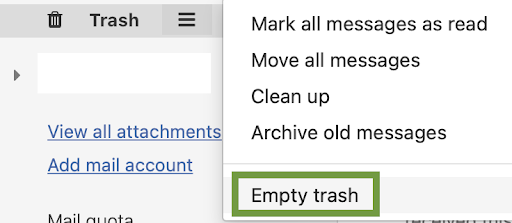
3. Regularly archive old messages
One more easy way to optimize your email storage is to archive the old emails you no longer need. The advantage of this option as opposed to simply deleting emails is that when archiving emails, those emails are moved to the Archive folder. The Archive folder contains a separate subfolder for each calendar year. The archived emails are saved to those subfolders sorted by the year of receipt.
There are two ways to use the Archive option. The first one is to archive individual emails. Simply select the emails that should be moved and click on Archive icon:
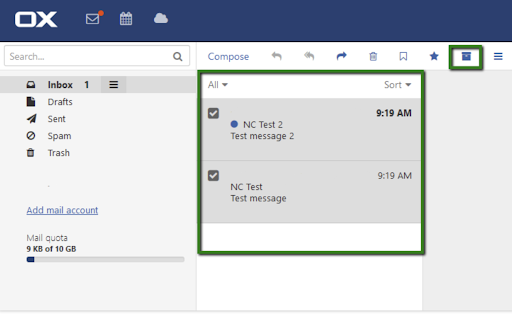
Additionally, you can archive emails within a folder that are older than 90 days. Select the needed folder, click on the folder-specific actions icon next to the folder name and hit Archive old messages:
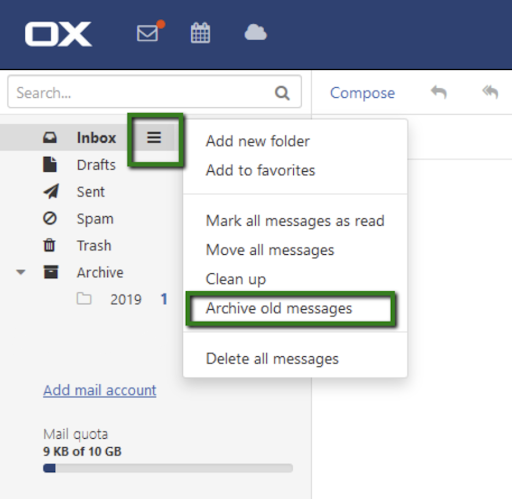
TIP: If you want to delete emails that are older than 90 days, you can archive them first and then delete them from the newly-created folder.
TIP 1: After archiving, emails are grouped into subfolders representing years. This makes it easier to review and delete emails in bulk. For example, you can remove old years’ folders that are no longer needed.
NOTE: Archiving emails can help improve performance, such as making search faster, but it does not reduce the disk space used in your Private Email mailbox. To free up space, you need to delete messages or move them to local storage outside your mailbox.
4. Avoid storing a lot of emails in one folder
We recommend that you keep messages in separate folders rather than keeping them all in your inbox. You can either create folders and move emails to them from the Inbox, or you can set up filtering so certain emails immediately get sorted into your folders. You can create filters in your Private Email webmail using this guide. Just choose File into as the action from the drop-down menu and choose the appropriate folder.
NOTE: We recommend that you have fewer than 10,000 emails in one folder for optimal functionality. In order to check the number of emails in the folder, just mouse over a folder, and the bubble with the number will show up.
5. Deleting unused folders
It may be worth reviewing the list of your folders to determine if there are any that you no longer need. If there are any that were created for temporary projects/issues that are not relevant anymore, you can either delete the folder or all the messages. In order to do so, select the folder in question, click on the folder-specific actions icon next to the folder name and hit Delete all messages/Delete:

6. Deleting mail with large attachments/large emails
You may also want to search for large emails that you can delete in order to free some space. Emails can be up to several MB in size due to large attachments. You can sort the message in your Private Email webmail and delete the largest ones by clicking Sort and choosing Size from the drop-down:
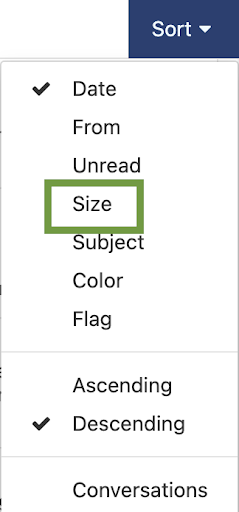
7. Optimize your mailbox with Outlook
If you are using Private Email with an Outlook email client and you added a large email account to Outlook, you may experience application pauses. The larger the data file, the more application pauses you may experience. You can use this guide for help with optimizing your storage.
8. Ensure that you receive desired emails only
While it’s true that our anti-spam system filters emails and blocks malicious ones, you may still receive emails that you don’t want, but they are not spam. In this scenario, we recommend reviewing the emails and unsubscribing from newsletters or marketing campaigns that may clutter your inbox. If there’s no possibility to unsubscribe from certain emails, you can always block unwanted senders or emails in the Jellyfish interface. Feel free to use this guide for this.
9. Add or distribute your Private Email storage
If you followed all the previous tips and you still need more storage, don’t fret. With Private Email, you can distribute email storage among your mailboxes. For example, you can add storage to a mailbox that’s almost full, using storage space from another one that doesn’t need the storage assigned to it. Feel free to refer to this guide for help.
If you do not wish to decrease Email Storage for the existing mailboxes, but still need more space, you can order an additional mailbox and use its email space.

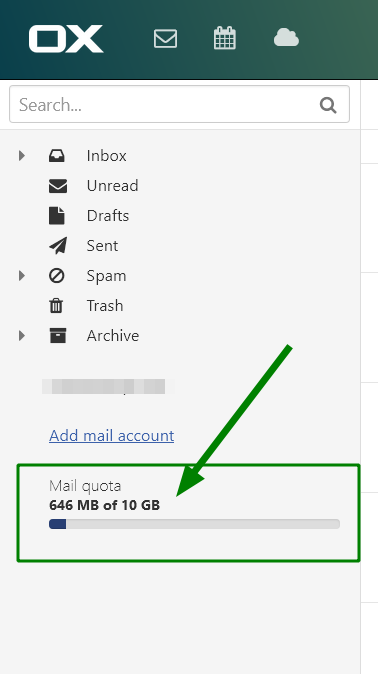
{}Need help? We're always here for you.
{}